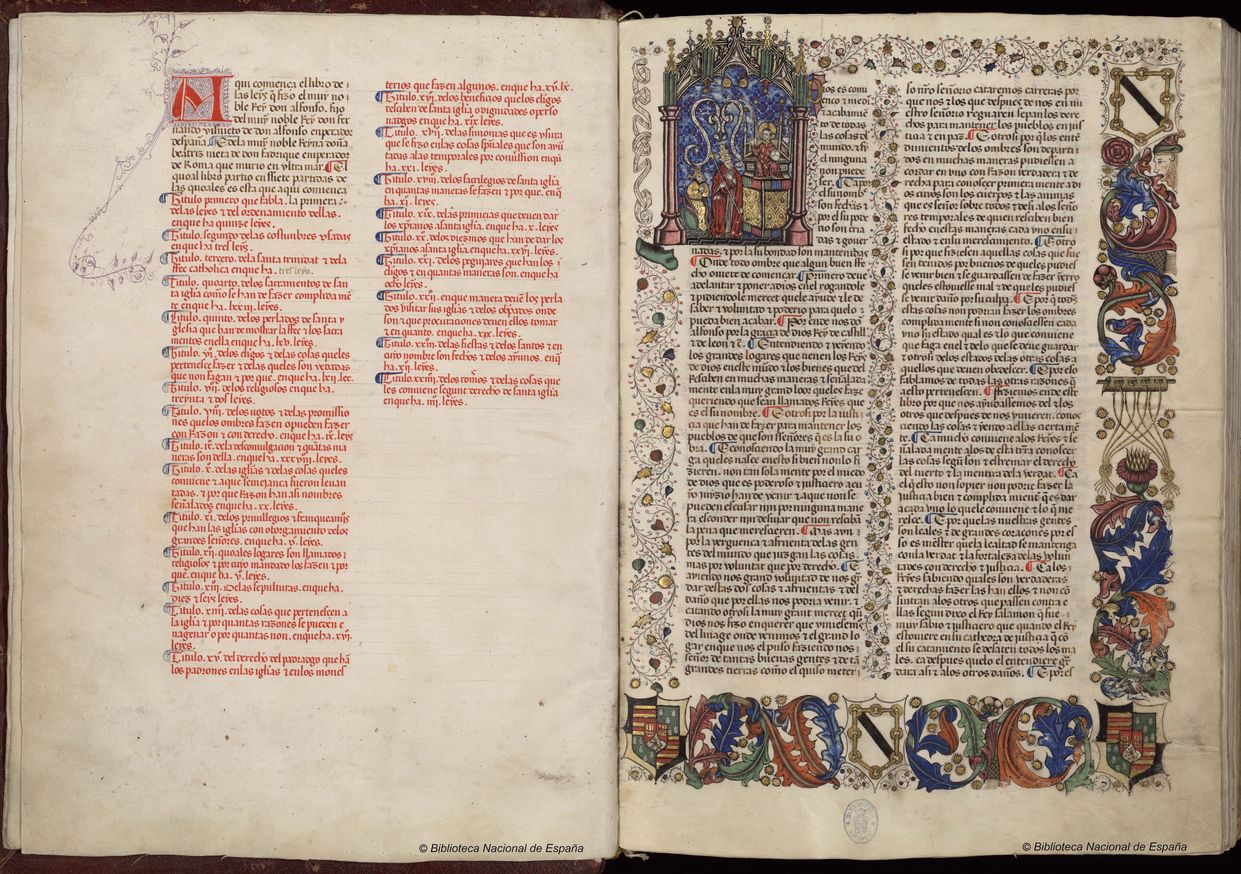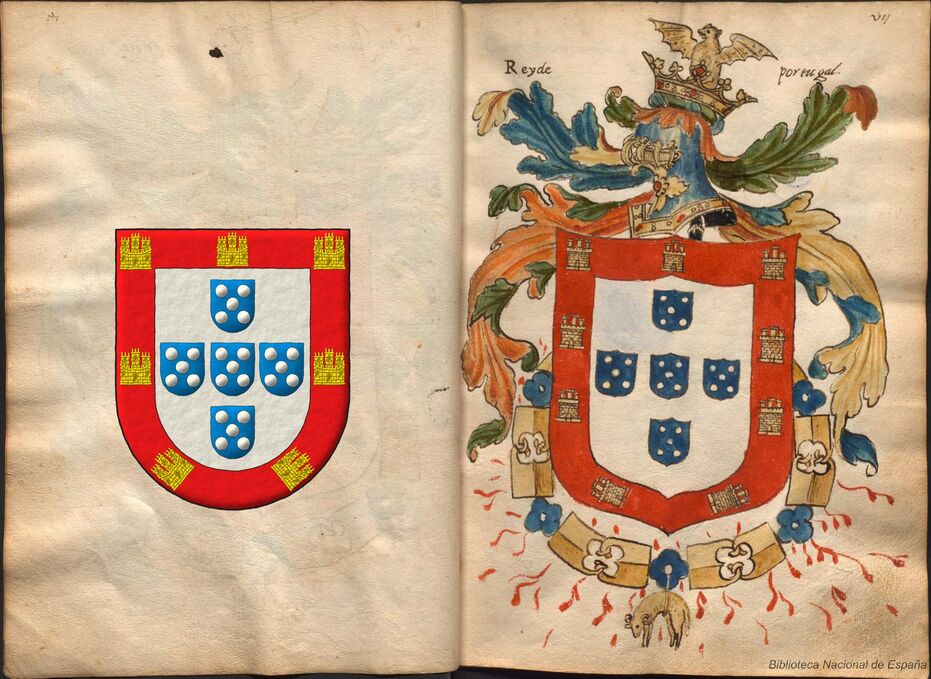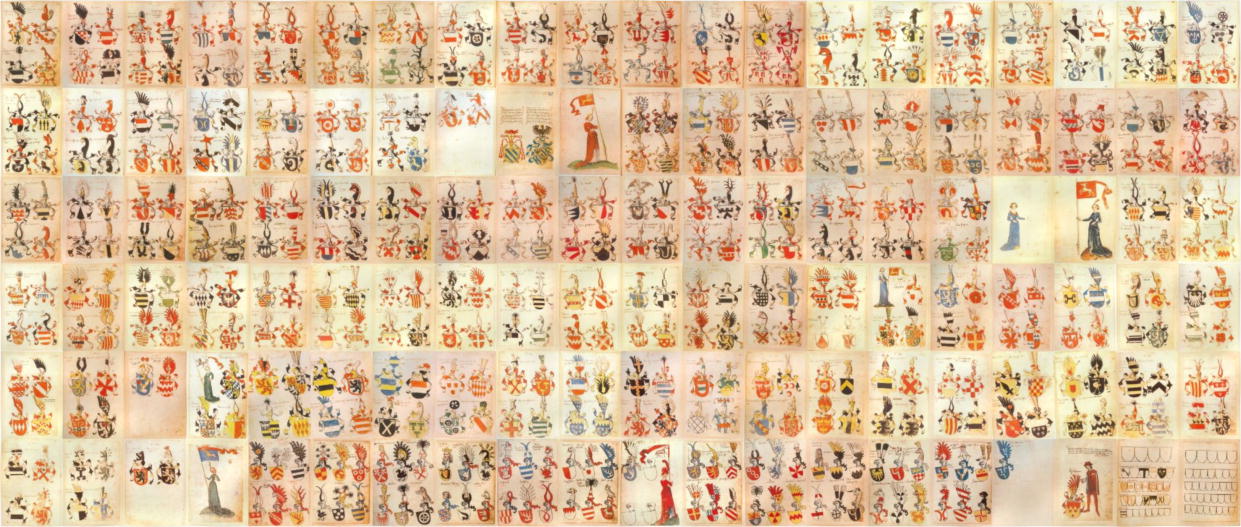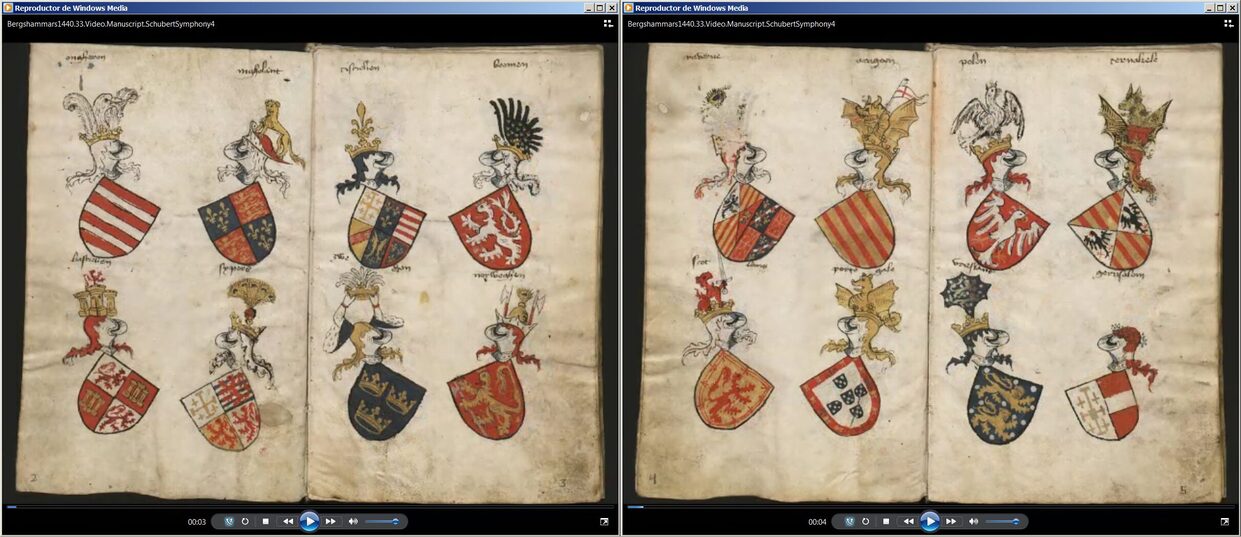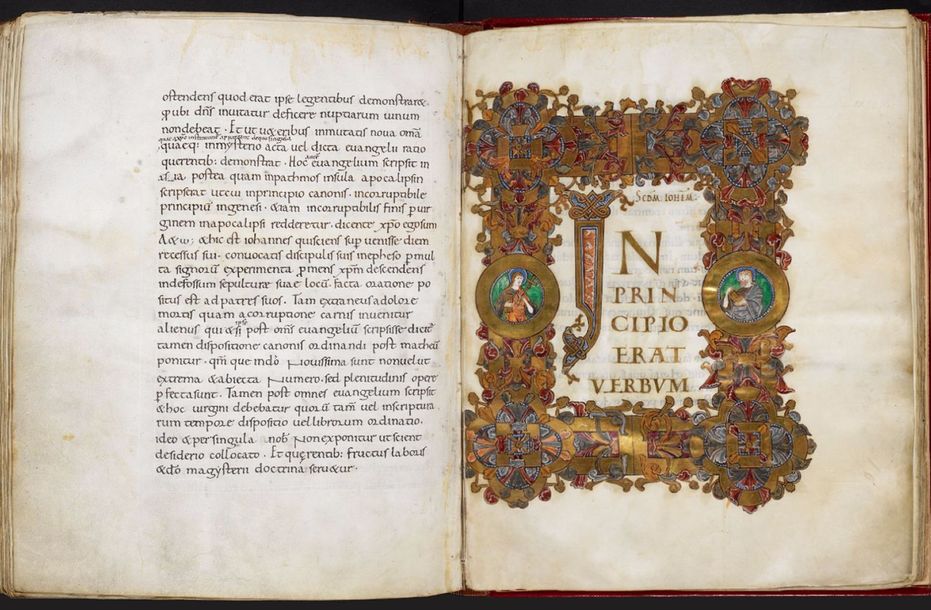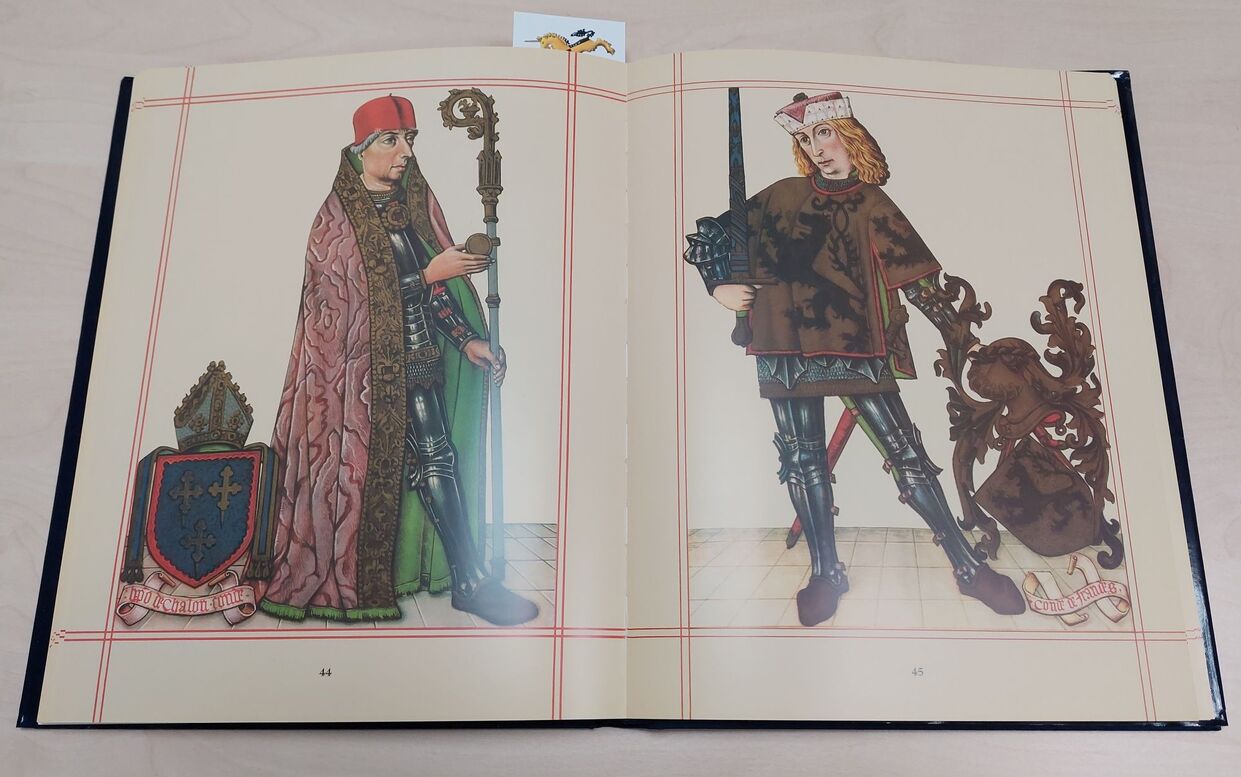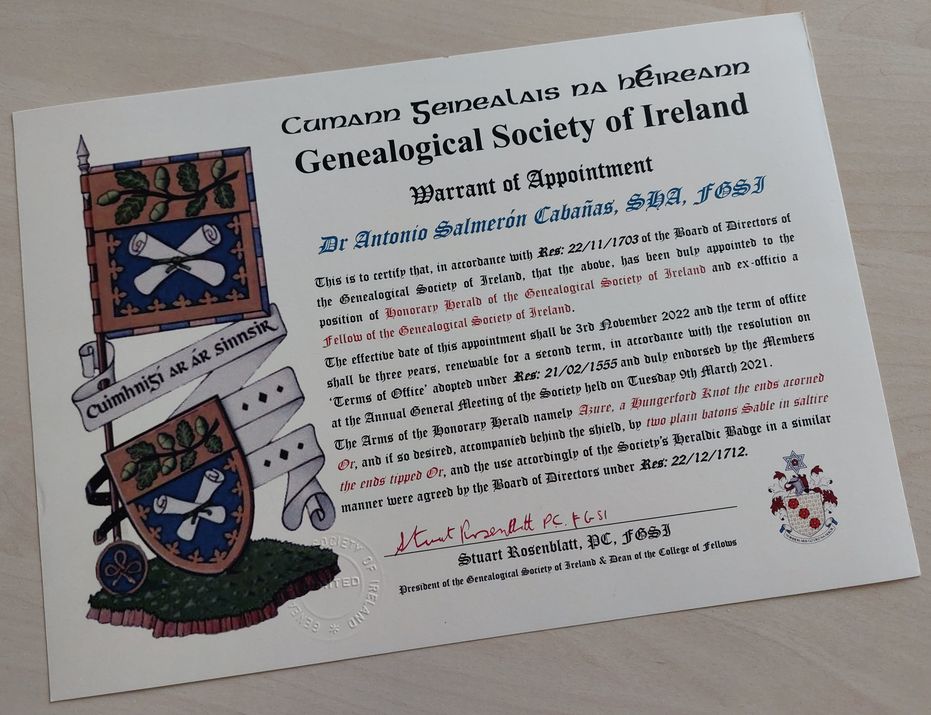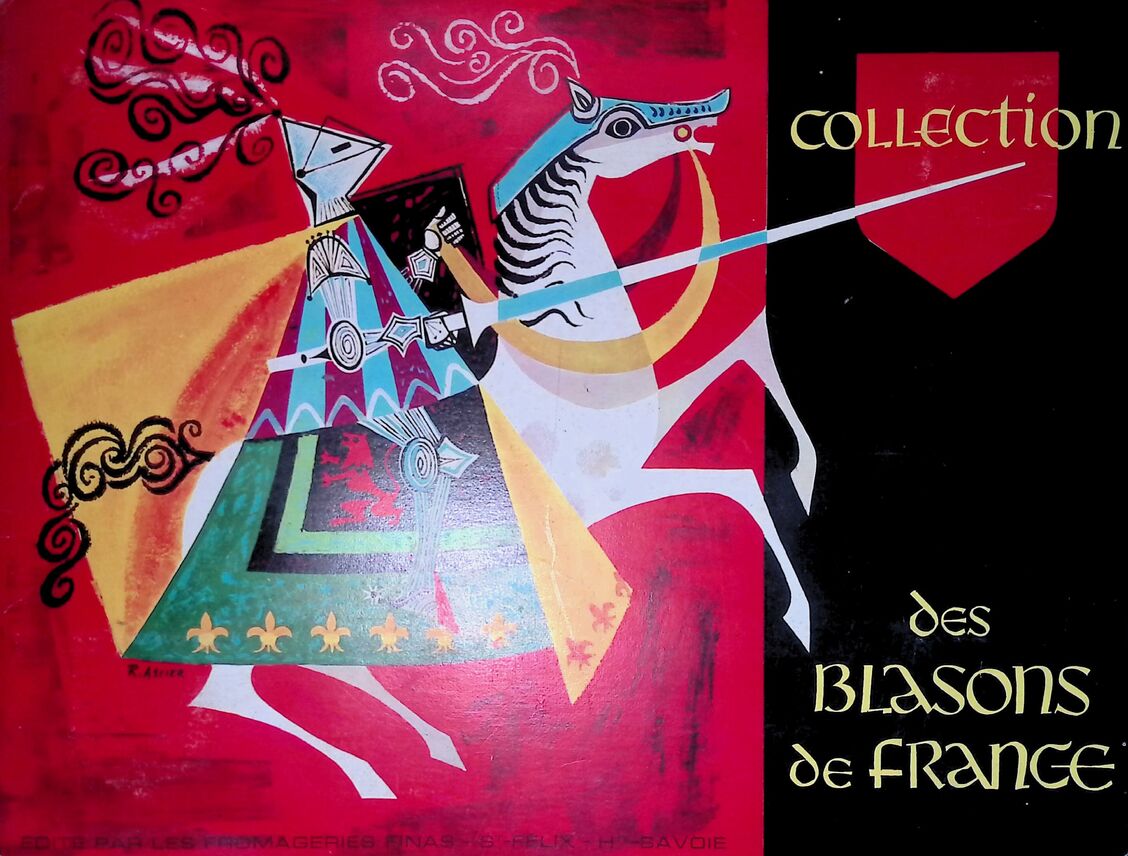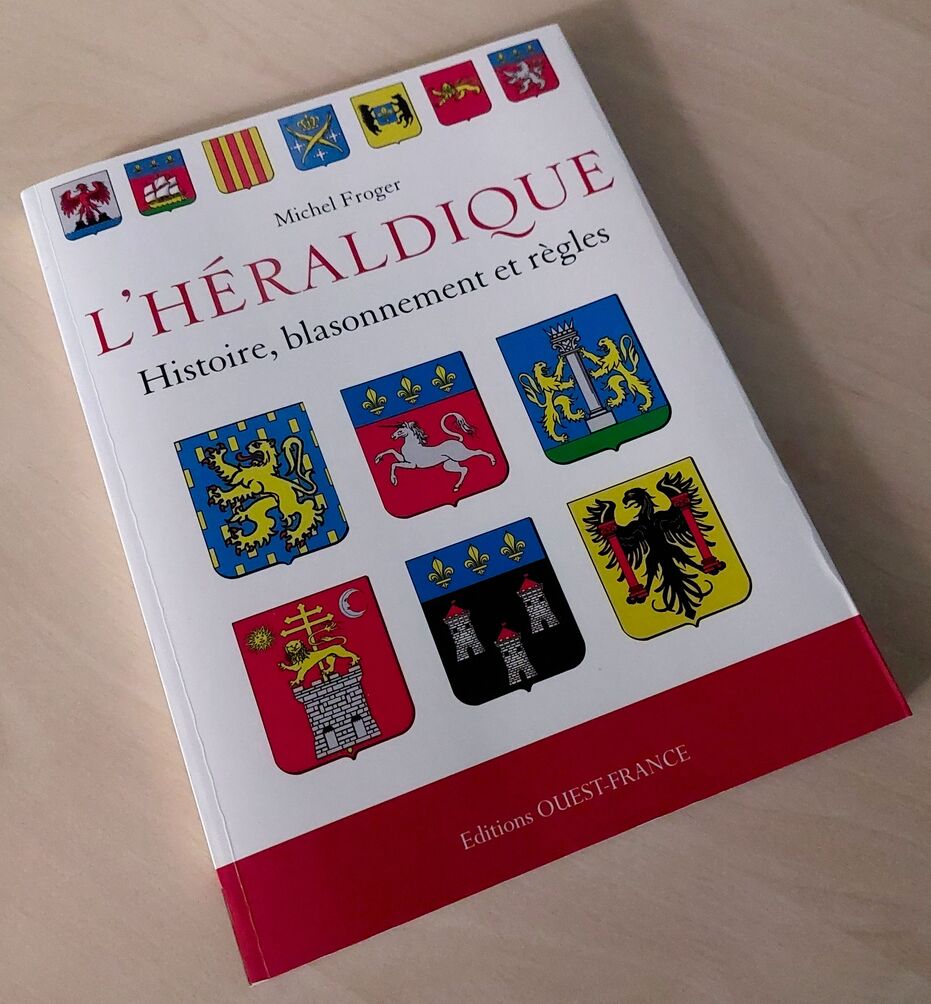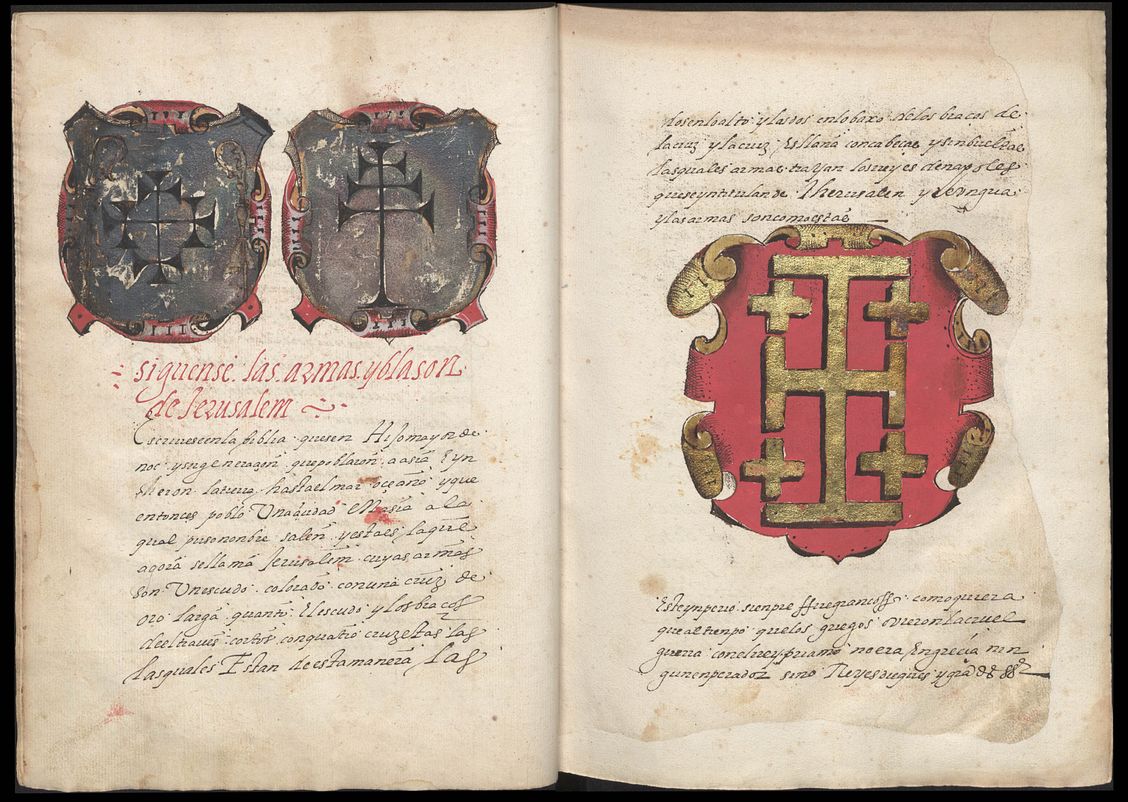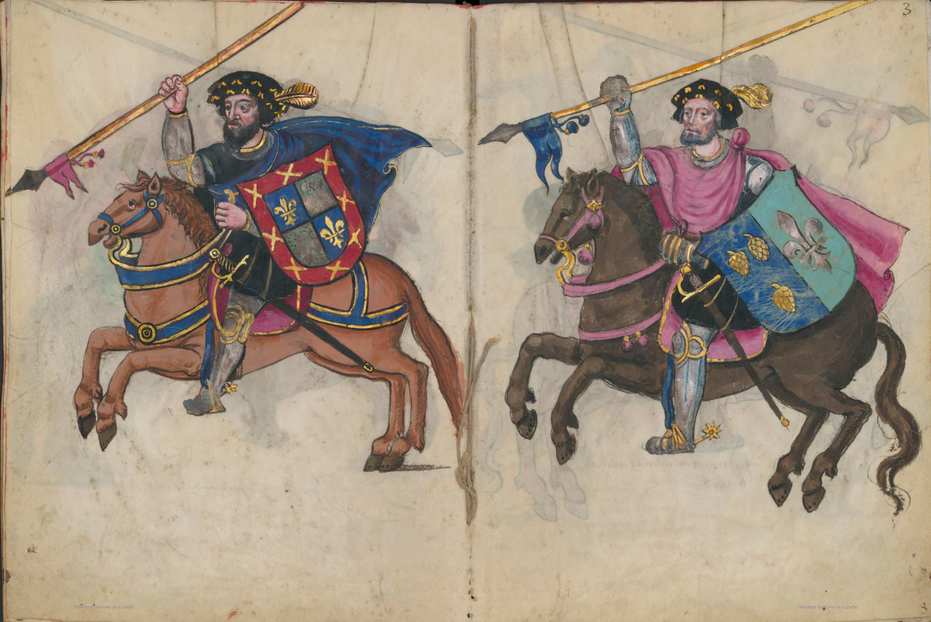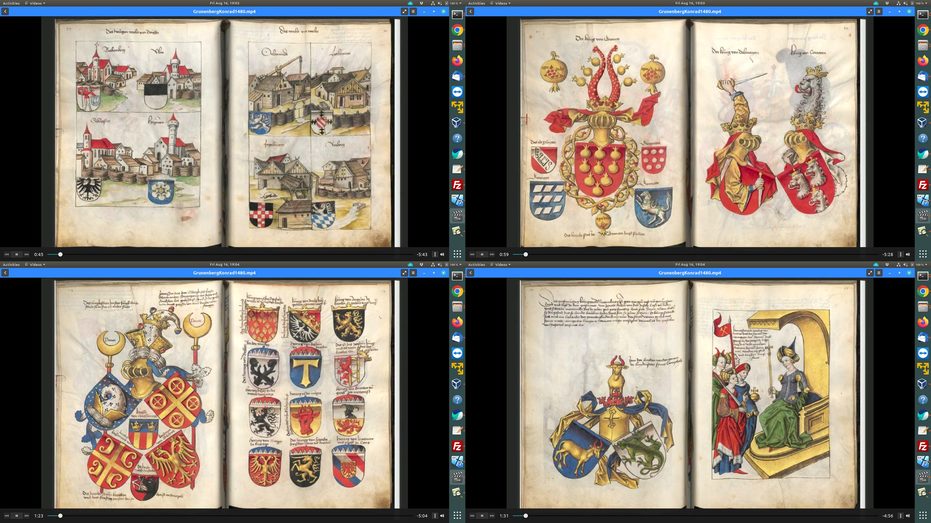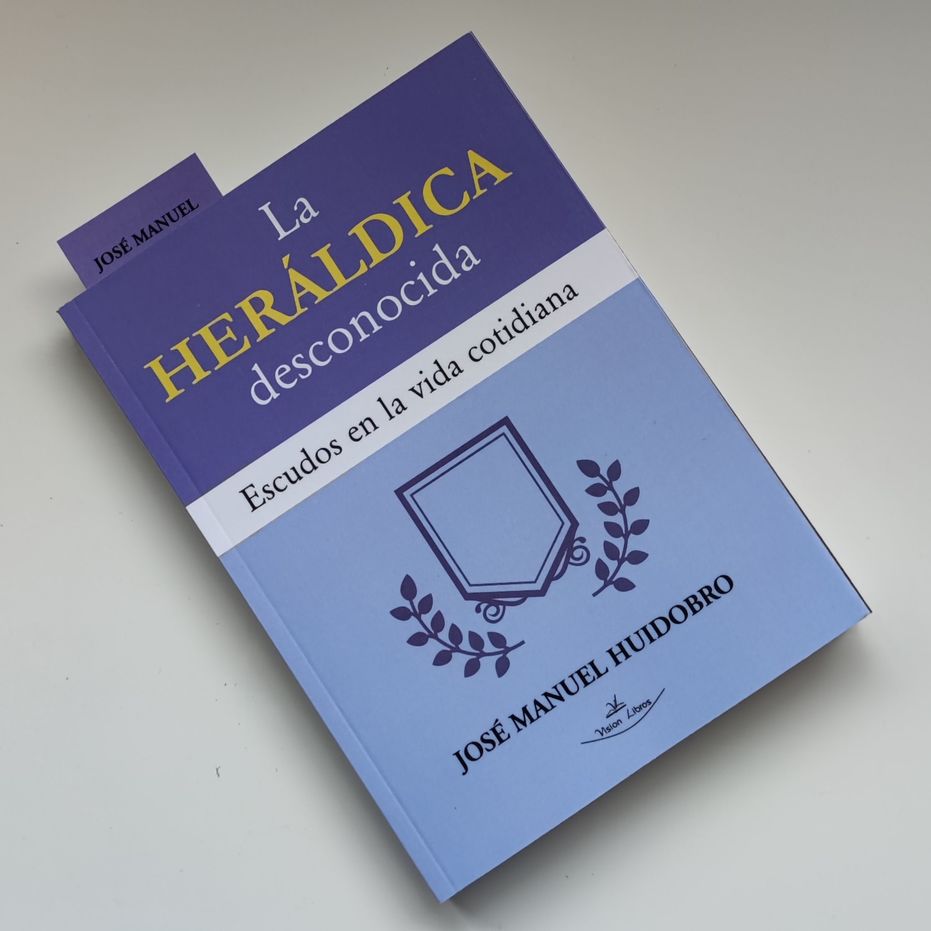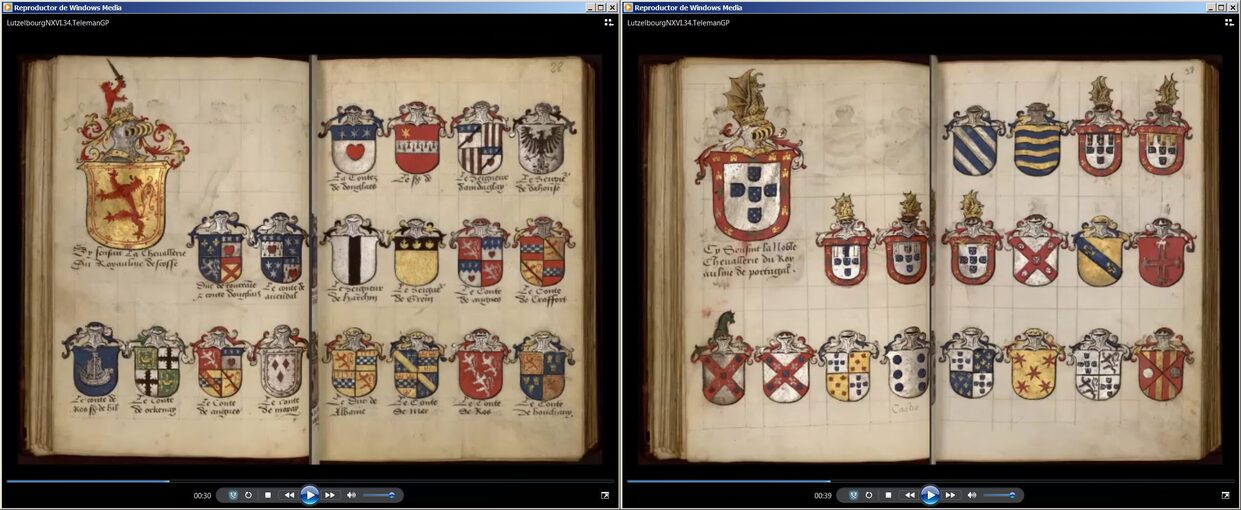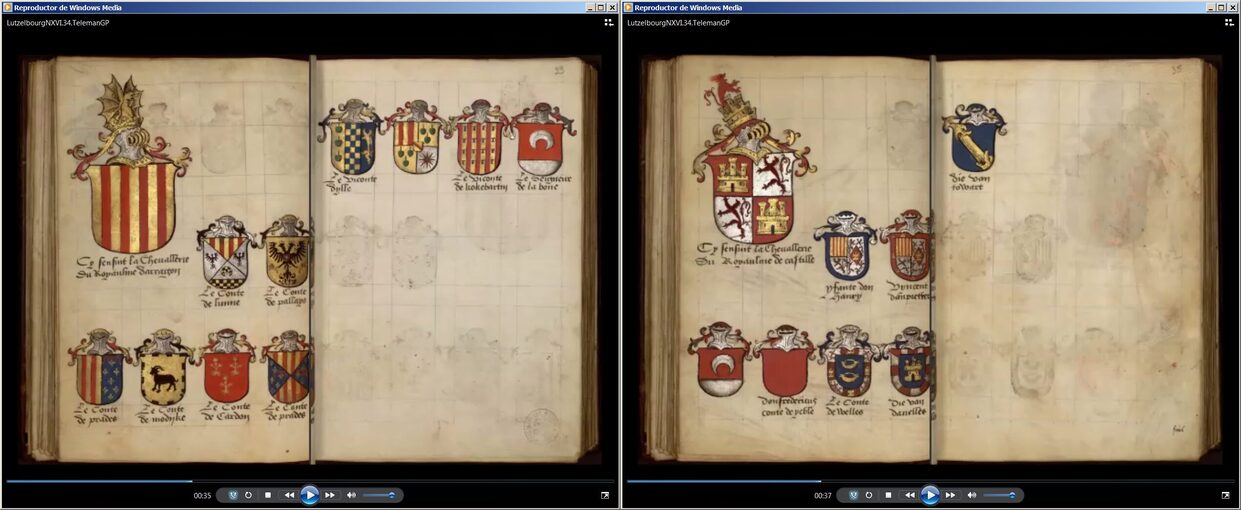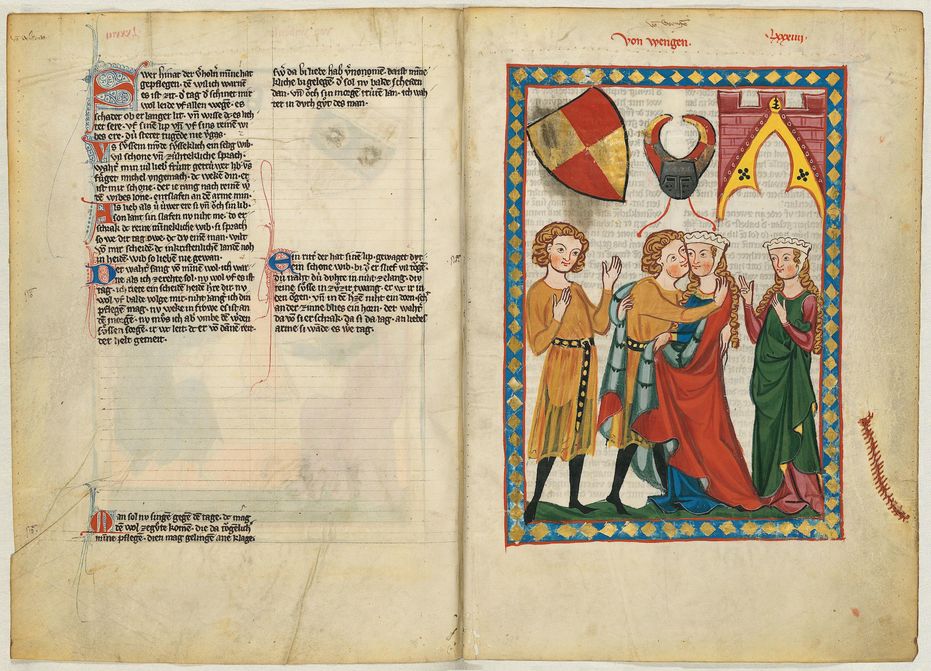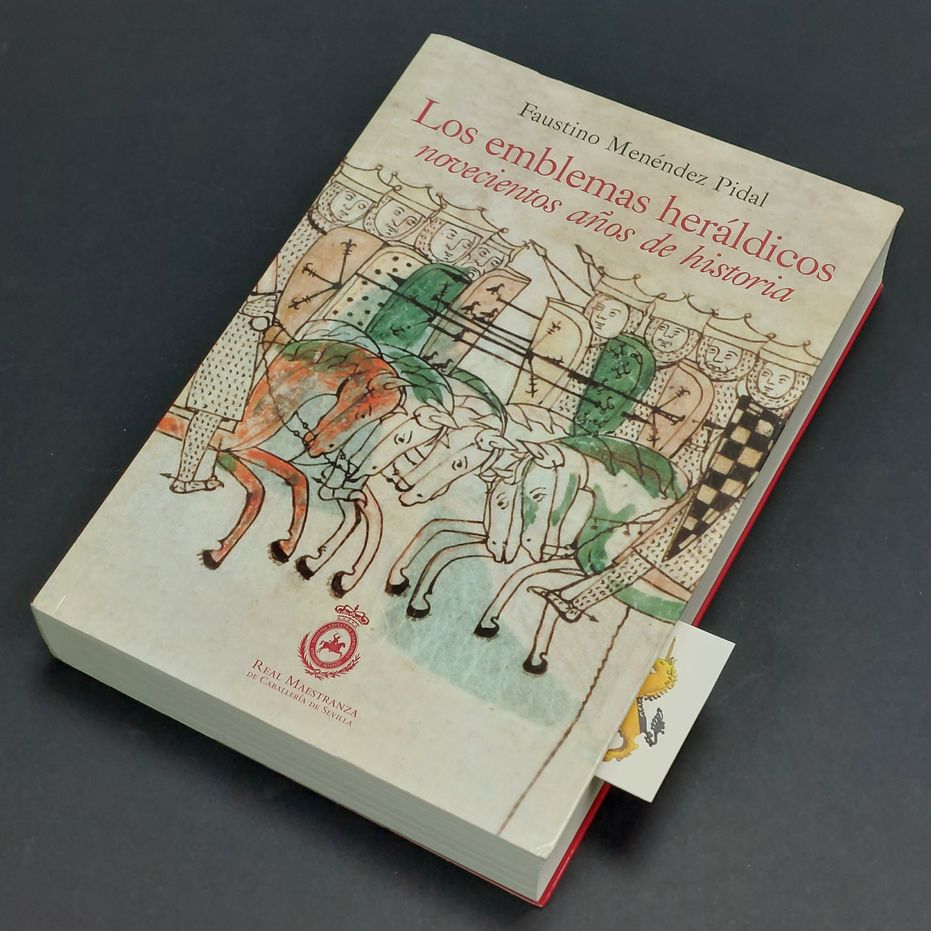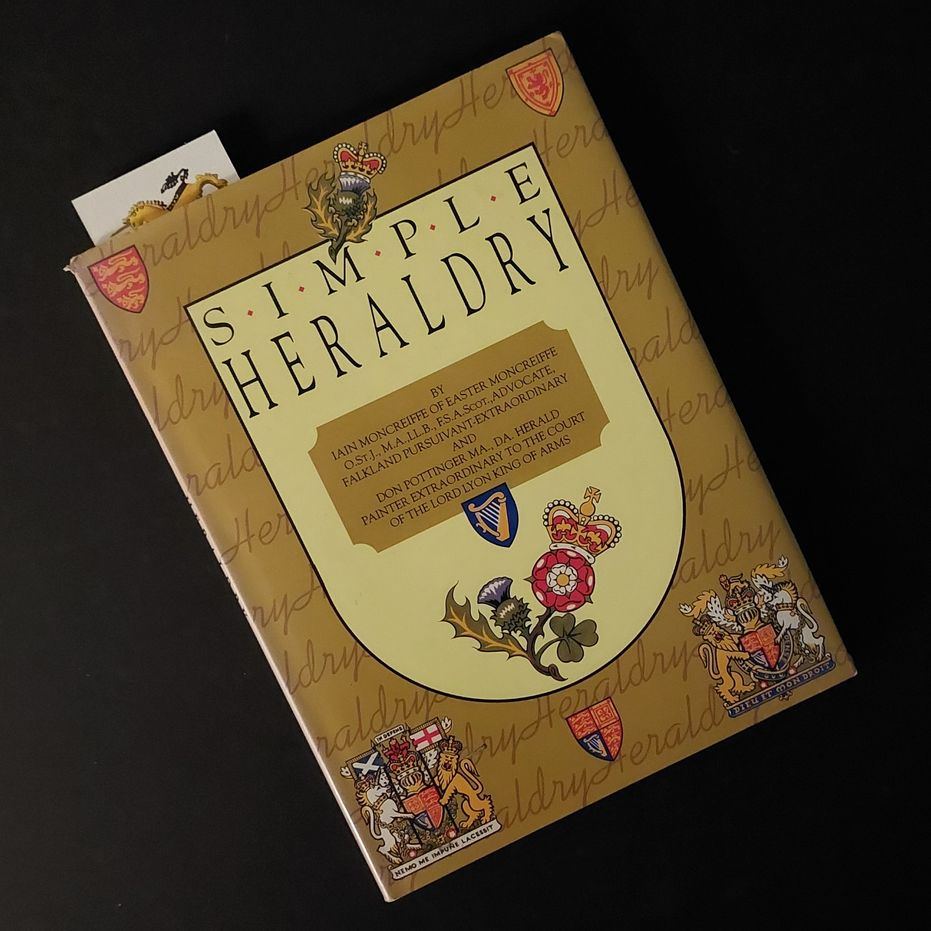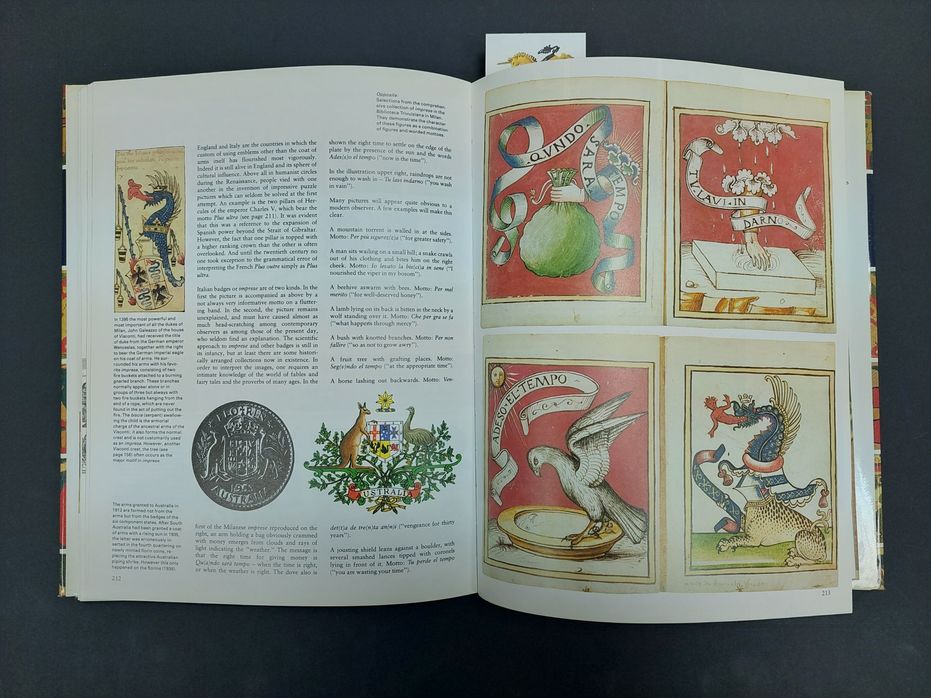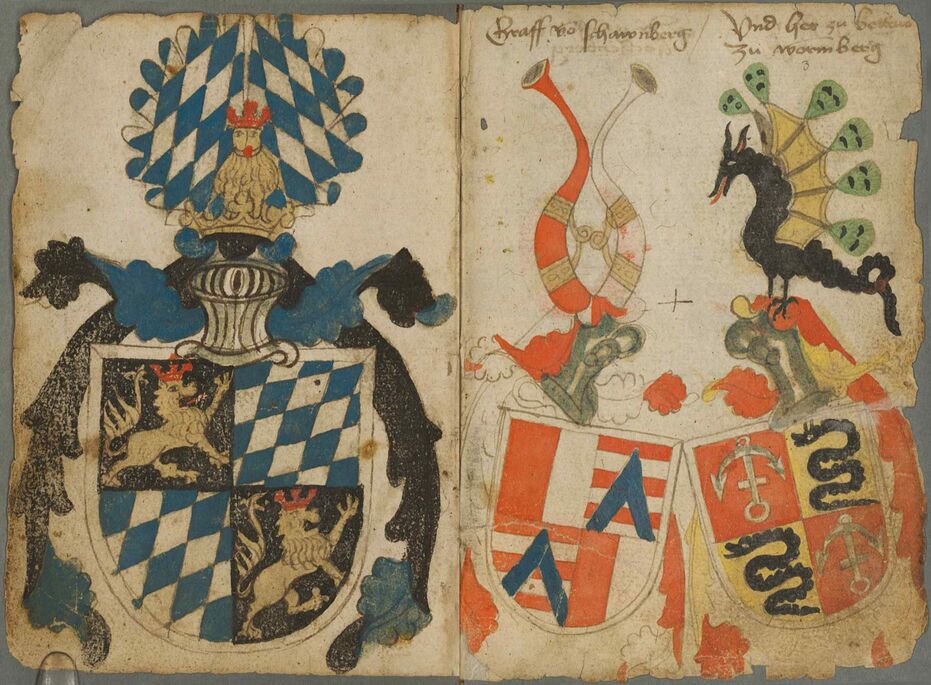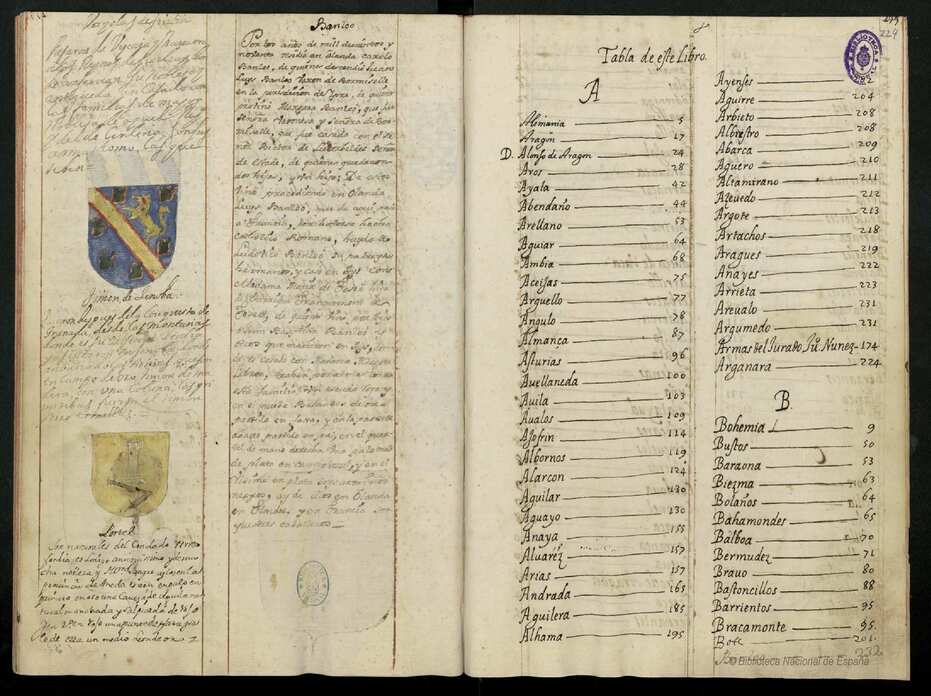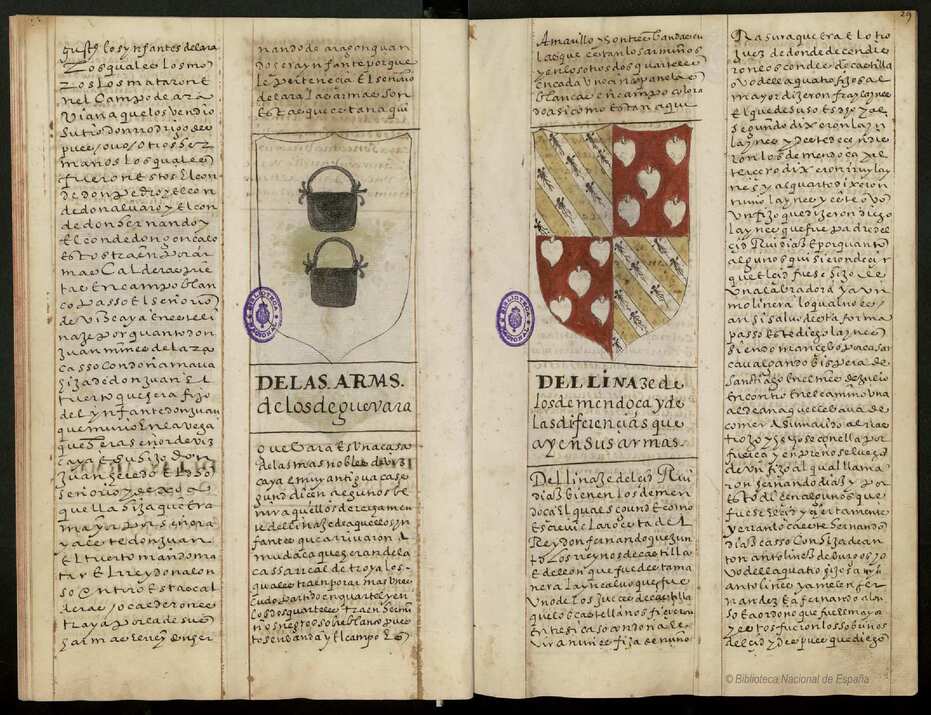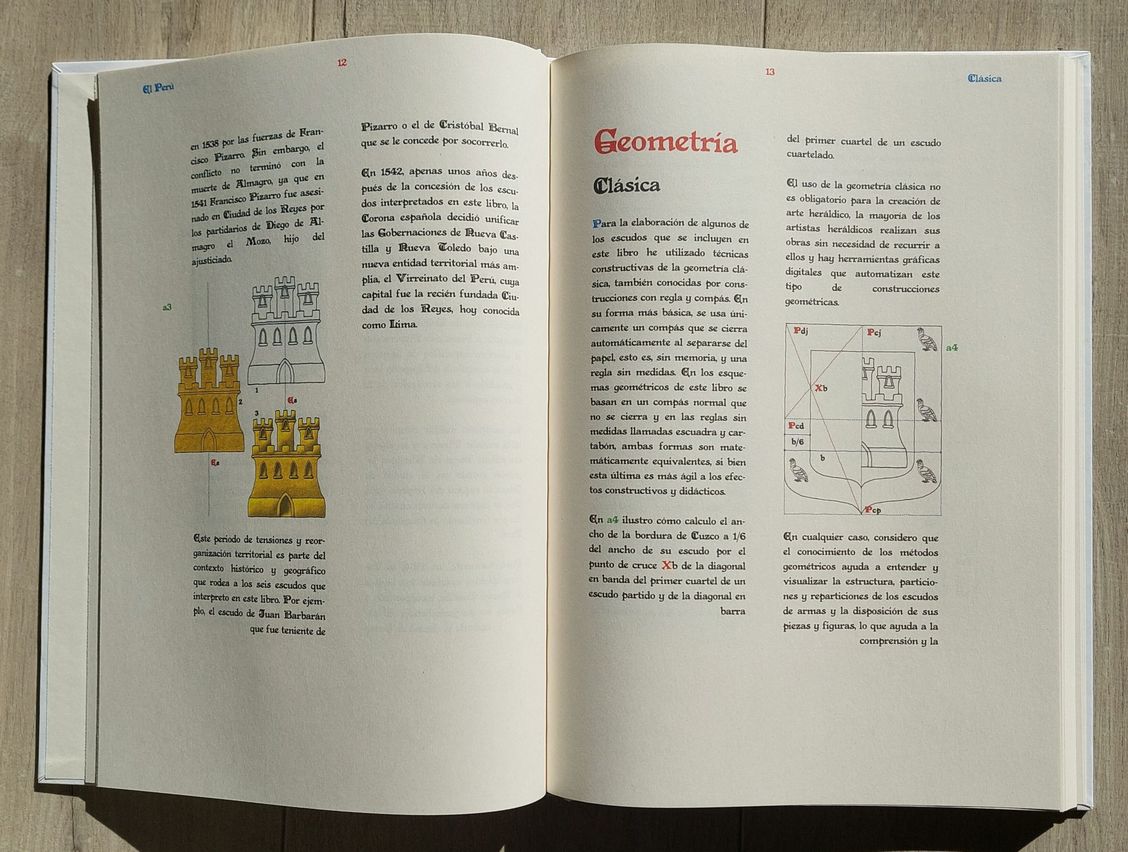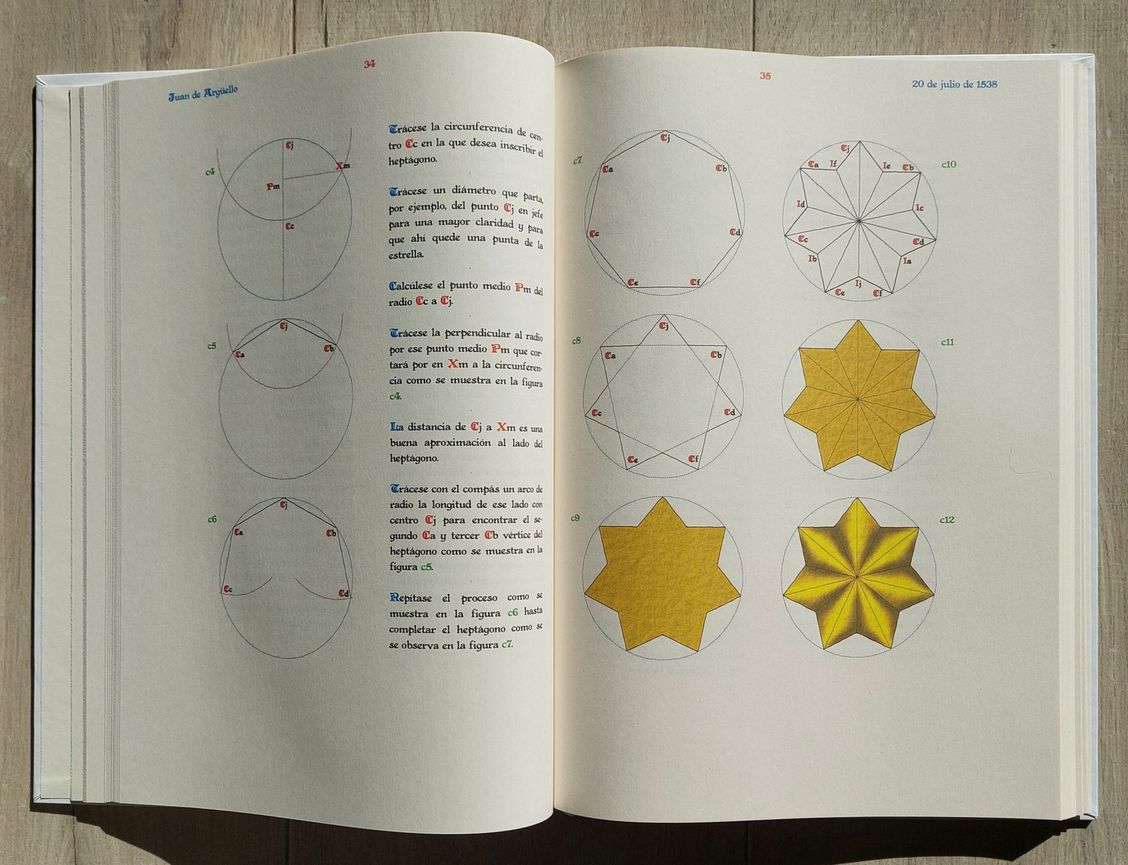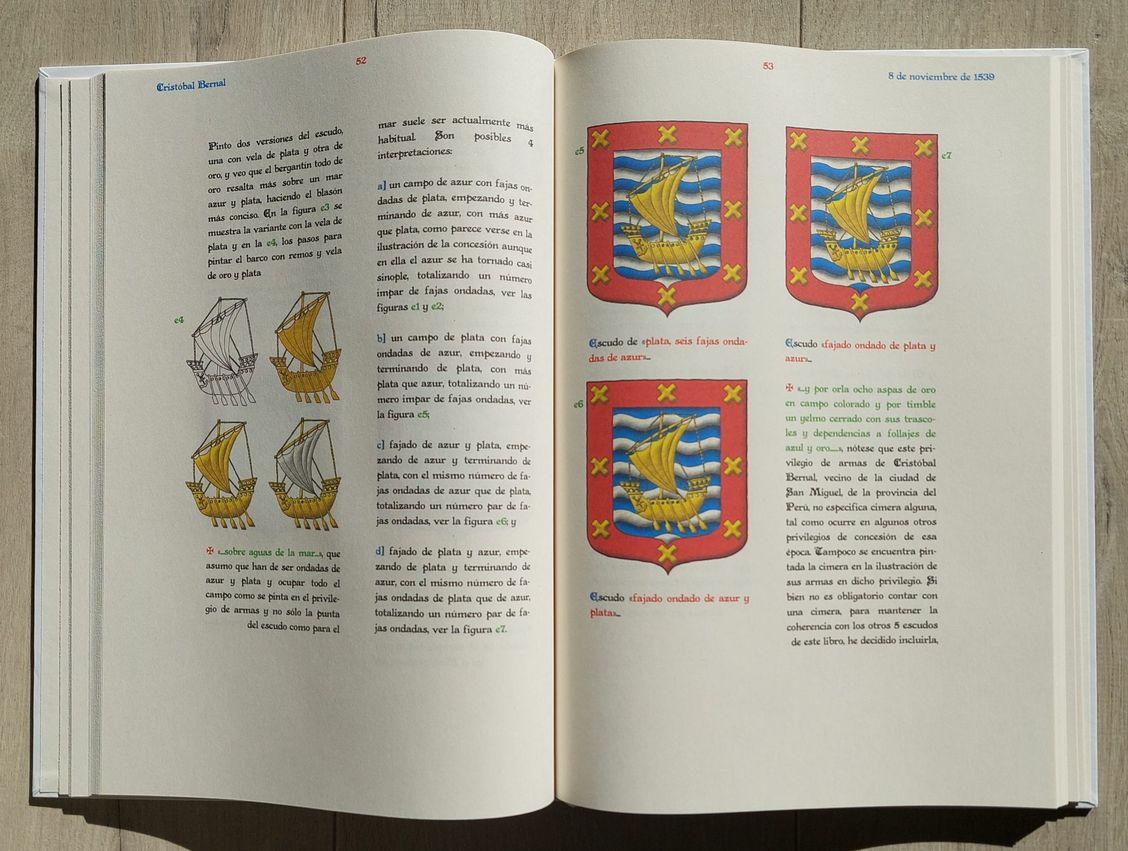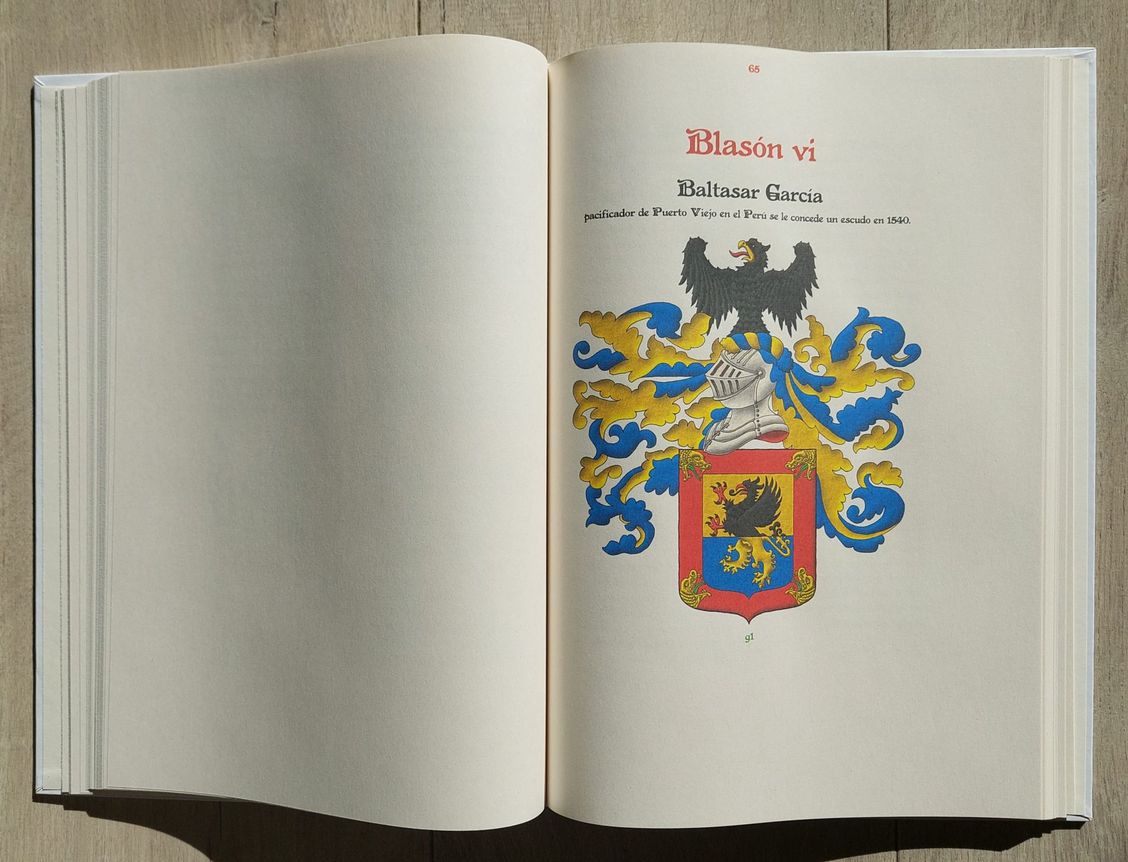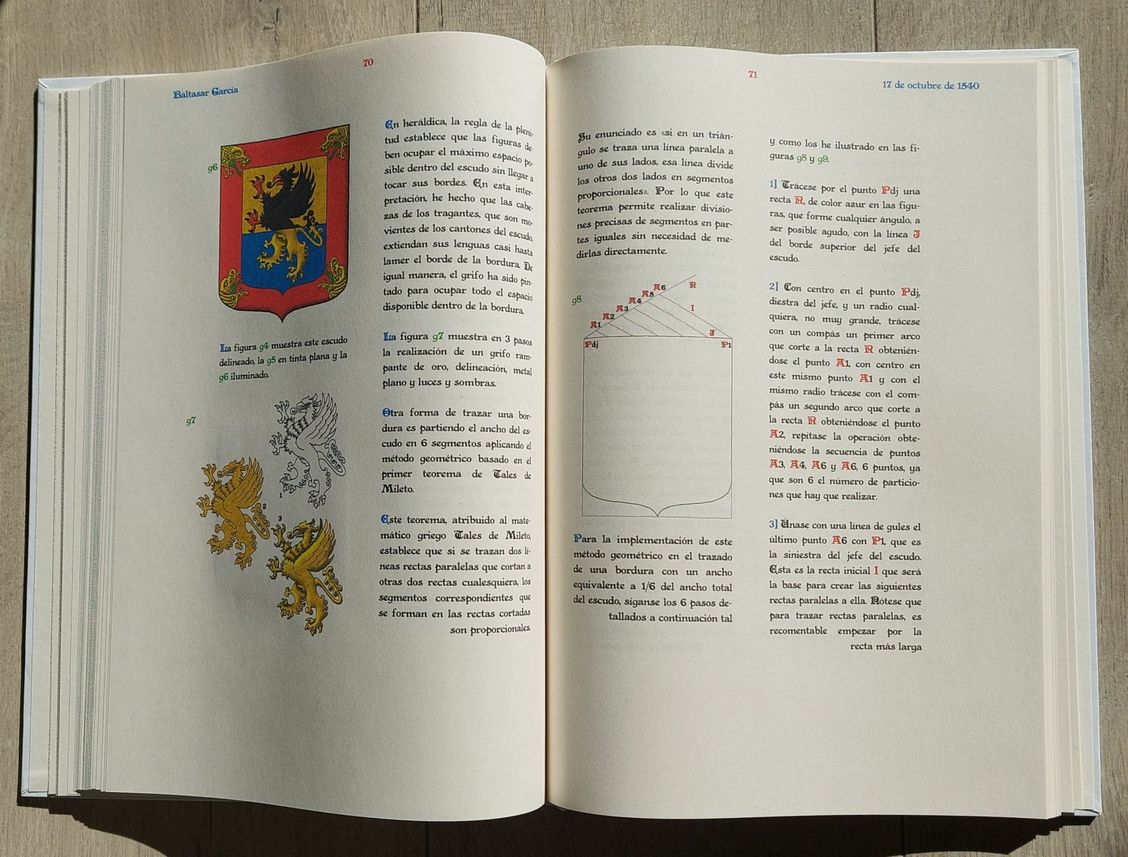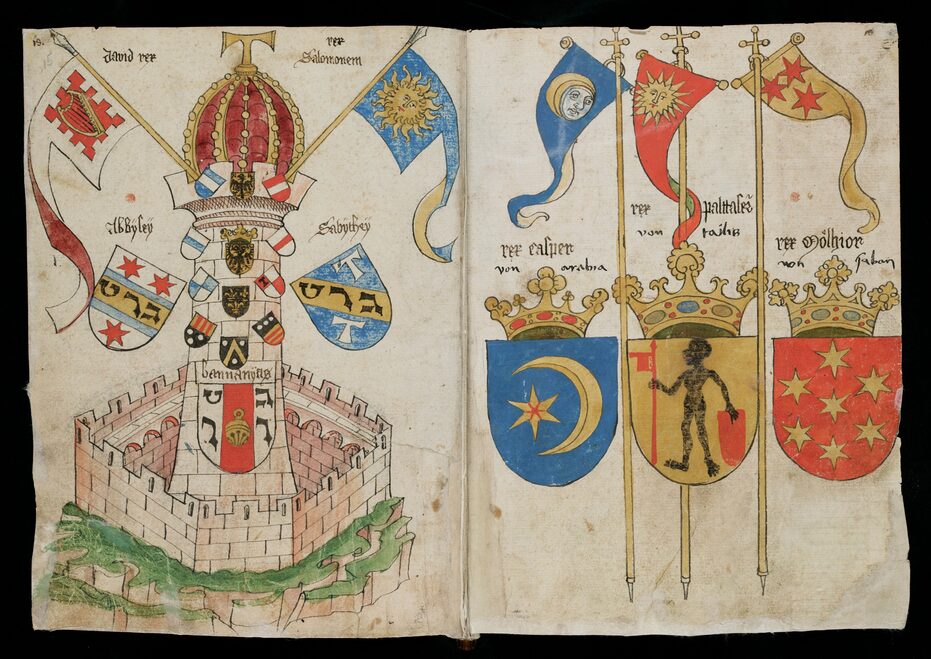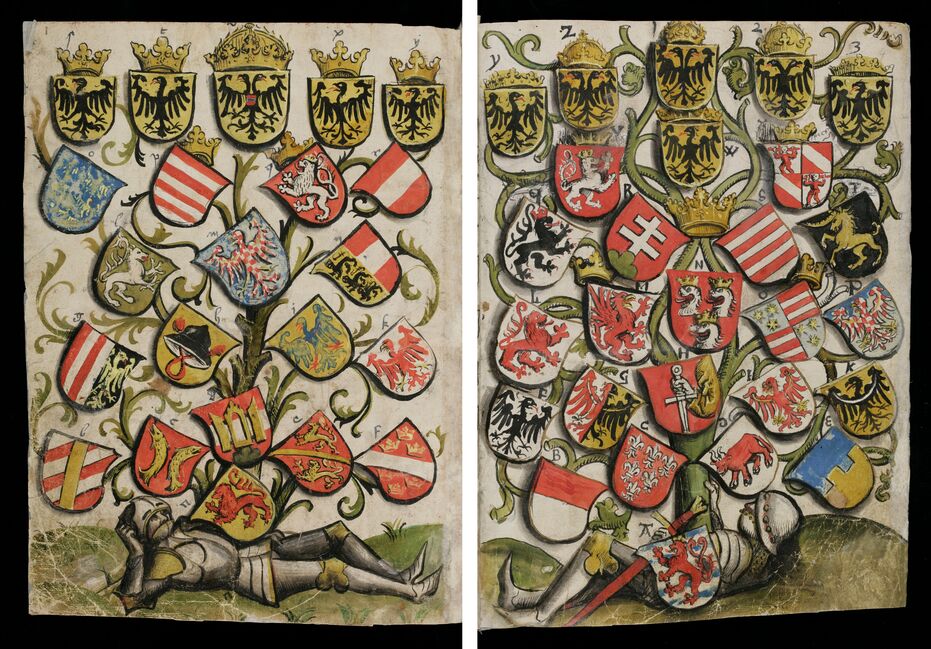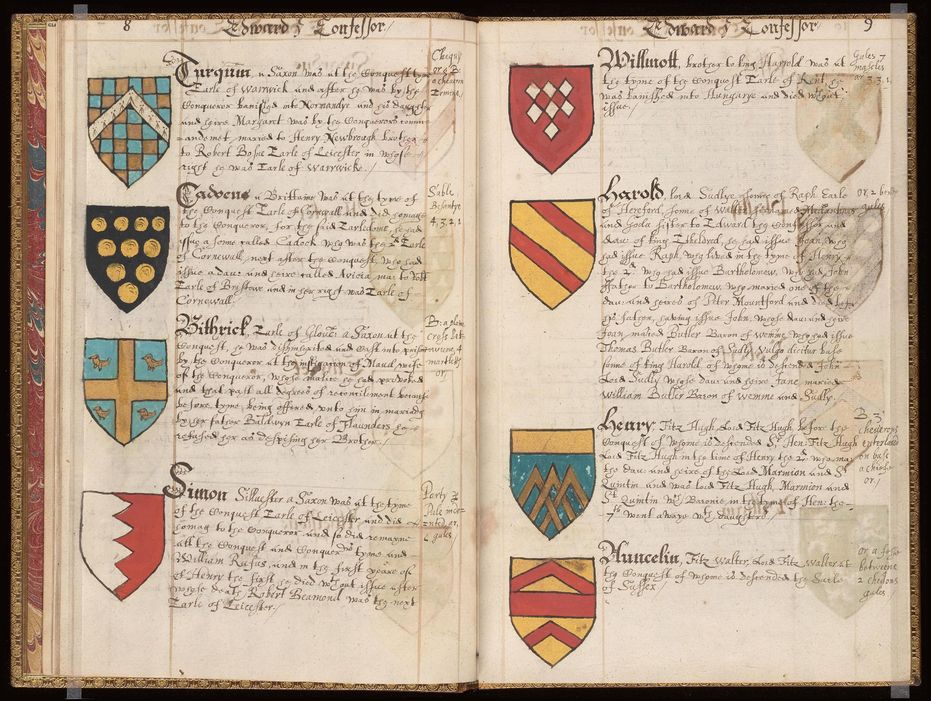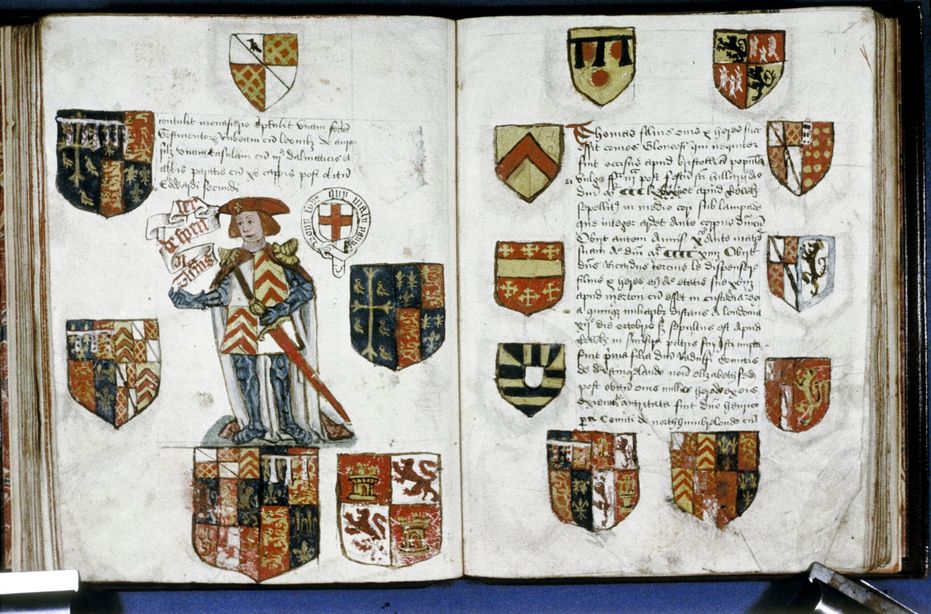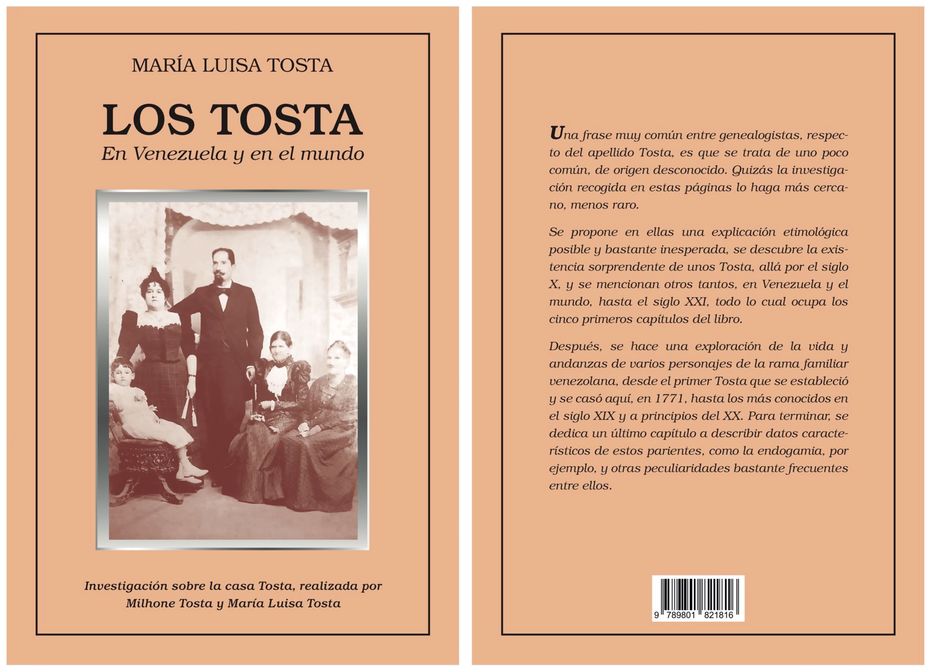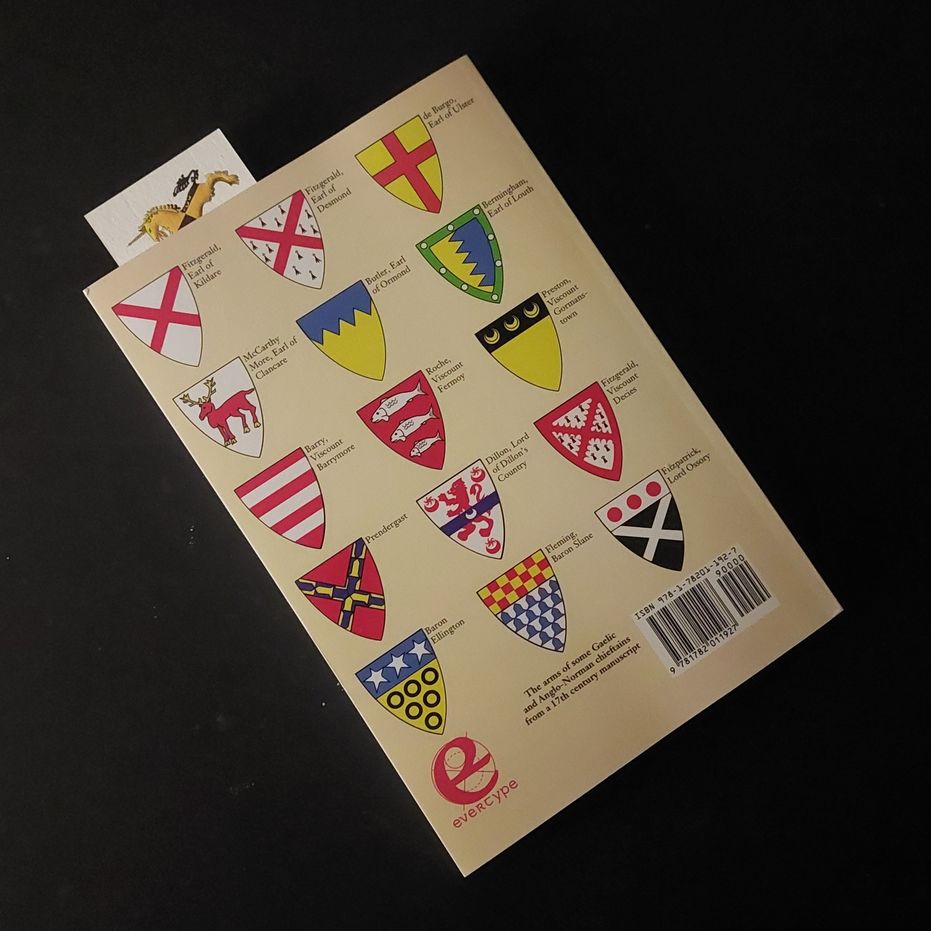In color


![Ver [Alfonso X of Castile; 1265] en referencias bibliográficas. Libro abierto, hojas de plata, filo de oro, guardas de gules, tapas de sable.](../css/Libro.Bibliografia.png)
Alfonso X of Castile; 1265
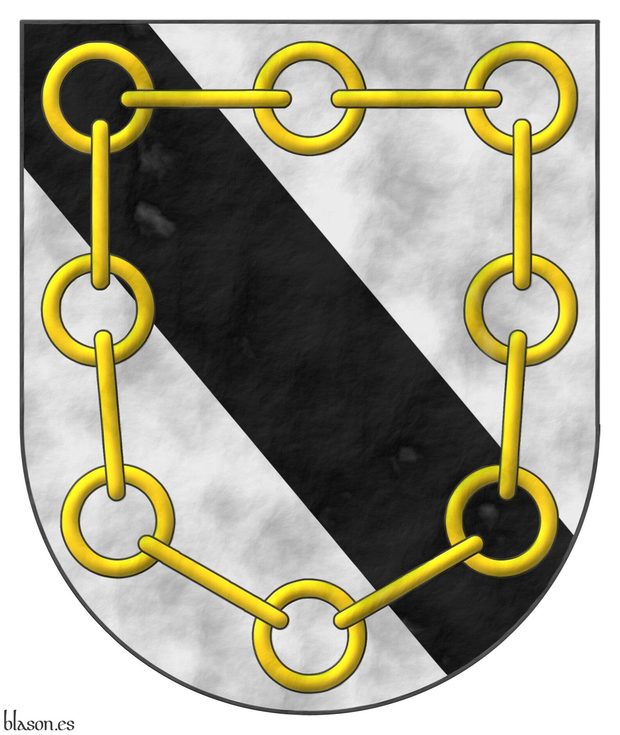
Alfonso X of Castile, The Wise, «The Seven-Part Code», its estimated completion year is 1265.
This is the copy I can consult, as it is available in the Hispanic Digital Library, it is a manuscript measuring 42 by 30 centimeters that once belonged to Álvaro de Zúñiga y Guzmán, first Duke of Arévalo, which later came into the possession of the Catholic Monarchs, initially Queen Isabella I of Castile, and after her death, King Ferdinand reclaimed it for the price of 5,251 maravedis. The original is housed in the National Library, in display case 4/6.
This copy, in addition to its numerous capital letters, has 8 illustrated pages, which according to its subsequent hand-numbering in pencil are:
- Page 6, among its illustrations can be seen 2 coats of arms of the Zúñiga family «Argent, a bend Sable, over all, a chain in orle Or», in this case formed by 16 links, 8 round and 8 more elongated placed in profile.
- Pages 106 and 191, on the latter can be seen a curious bishop-lizard climbing.
- Pages 294 and 331, on the 2nd at the bottom, a maiden is seen walking a monkey to relieve itself and to her right a fight of men with beast bodies.
- Page 379 and on its previous unnumbered page, and finally, on page 415 which begins with a tournament where the 2nd knight bears the ancient arms of France «Azure, semy of fleurs de lis Or».
The coat of arms that illustrates this bibliographic reference is that of Álvaro de Zúñiga y Guzmán. For the creation of his chain, I followed the illustration of his 2 coats of arms on the already mentioned page 6 of this manuscript.
It is one of my favorite manuscripts and, perhaps, the one with which I have created the most things.
Bibliographical reference of century XIII.
Classification: Castilian language, Manuscript and In color.
Author: Alfonso X of Castile.
The following article cites this bibliographic reference:
External resources:
- National Library of Spain.
- Indirect access to the Library of Congress of the United States of America.
- Direct access to the Library of Congress of the United States of America.
Internal resources: AlfonsoXDeCastilla1265.7Partidas.10642.pdf.


Annual Heraldry Ireland Lecture by Martin Goldstraw
As the Honorary Herald of the Genealogical Society of Ireland, I have cohosted alongside Laura Price, MGSI, the Annual Heraldry Ireland Lecture by Martin S. J. Goldstraw, director of The Armorial Register.
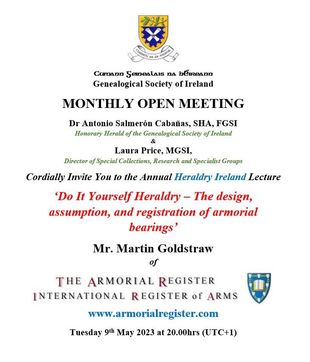
Introduction to the speaker and his lecture
Welcome to the Genealogical Society of Ireland's Annual Heraldry Ireland Lecture, «Do It Yourself Heraldry - The Design, Assumption, and Registration of Armorial Bearings» presented by Mr. Martin Goldstraw of the Armorial Register.
In many countries around the world, such as Ireland, the United States, Italy, and Spain, citizens are free to assume their own coat of arms. There are usually few restrictions on assuming a coat of arms, for example, the design must follow the rules of heraldry, one cannot copy another person's coat of arms, or it cannot contain illegal symbols in that country.
Thanks to this, we can all have our own coat of arms, allowing us to use the symbolic and communicative power of heraldry to identify and empower ourselves. In this way, many people around the world, of all ages and backgrounds, assume their coat of arms, and this is happening with a growing trend due to the spread of heraldry through the internet and social networks.
The heraldry, which has distilled a written and artistic language over centuries that allows us to project our identity with prestige, clarity, universality, and permanence, reaches us in this third millennium full of strength and freshness, and, therefore, the assumption of a coat of arms uses to be a source of joy for individuals and their families.
Today, on May 9th, we celebrate Peace and Unity Day in Europe, and we have chosen this day because heraldry is a common heritage of all Europeans, which we have taken with us around the world and that especially unites us. This is because there is more visual and spoken proximity between the painted and written blazons of European countries than between their own languages, such as French, English, Spanish, Italian... for example, notice the closeness between «d'or, au lion rampant de gueules», «Or, a lion rampant Gules», «de oro, un león rampante de gules», «d'oro, al leone rampante di rosso»,... and we will all see the same: a red lion, rising and roaring on a golden field.
And now, without further ado, let us introduce our magnificent guest for this very special day: Mr. Martin Goldstraw is the author and illustrator of the Cheshire Heraldry website and the books Cheshire Heraldry, The Visitations of 1533 to 1580. He is also one of the two Directors and a founder of the publishing company The Armorial Register Ltd. And his lectures are engaging and highly informative.


![Ver [Avilés, T. de; XVI] en referencias bibliográficas. Libro abierto, hojas de plata, filo de oro, guardas de gules, tapas de sable.](../css/Libro.Bibliografia.png)
Avilés, T. de; XVI
Tirso de Avilés, continued by Martín de Bolea y Castro, «Roll of arms», 3 volumes, Volume I, coats of arms of kings, princes and grand titles, 208 hand-numbered pages in Roman numerals, Volume II, coats of arms of noble and private titles, 129 hand-numbered pages in Arabic numerals, Volume III, coats of arms of popes, cardinals, archbishops and bishops, 185 hand-numbered pages in Arabic numerals, in the National Library of Spain, signatures Mss/12550 V.1, Mss/12551 V.2 and Mss/12552 V.3, it is estimated from the XVI century.
Bibliographical reference of century XVI.
Classification: Manuscript, Armorial roll, In color and Castilian language.
The author is Avilés, Tirso de.
The following article cites this bibliographic reference:
External links:
- Detail of this armorial in the National Library of Spain.
- Bibliographic record of the National Library of Spain.
- Scanned Armorial in the National Library of Spain.
Internal resources: Volume I AvilesTdeXVI.11.Tomo01.pdf, Volume II AvilesTdeXVI.11.Tomo02.pdf and Volume III AvilesTdeXVI.11.Tomo03.pdf.
Credits: This book belongs to the Biblioteca Nacional de España. License Creative Commons CC-BY. You may share, transform and create from images in the public domain that are accessible in the Hispanic Digital Library.


![Ver [Becher, C.; Gamber, O.; 1986] en referencias bibliográficas. Libro abierto, hojas de plata, filo de oro, guardas de gules, tapas de sable.](../css/Libro.Bibliografia.png)
Becher, C.; Gamber, O.; 1986
Charlotte Becher and Ortwin Gamber, «Die Wappenbücher Herzog Albrechts VI. von Österreich: Ingeram-Codex der ehem, Bibliothek Cotta, Volume 1», editado por Böhlau Verlag Wien, 178 pages, ISBN 3-205-05002-9 y 978-32-05050-02-5, Vienna, Cologne, Graz, 1986.
Dedicated exclusively to the study and analysis of the armorial [Ingeram, H.; 1459].
Bibliographical reference of century XX.
Classification: German language, Manuscript, Armorial roll and In color.
Authors: Becher, Charlotte and Gamber, Ortwin.
The following article cites this bibliographic reference:
External resource:


![Ver [Bergshammars; 1440] en referencias bibliográficas. Libro abierto, hojas de plata, filo de oro, guardas de gules, tapas de sable.](../css/Libro.Bibliografia.png)
Bergshammars; 1440
Anonymous, «Roll of arms», roll of arms manuscript called Bergshammars, written, emblazoned and edited in Brabant, Burgundian Netherlands, during the years 1440-1456, 493 pages numbered later in pencil, contains coats of arms of several European kingdoms, on page 488 the year 1553 seems to be written, Brabant, ca 1440.
Bibliographical reference of century XV.
Classification: Armorial roll, Manuscript and In color.
The author is anonymous.
Bibliographic reference mentioned in the following articles:
External links:
Internal resources: Bergshammars1440.33.Video.Manuscript.SchubertSymphony4.mp4 a video lasting 7 minutes and 11 seconds, sound track Symphony No. 4 in C minor, D 417, called Tragic, composed by Franz Schubert in April 1816, when he was 19 years old.


![Ver [Charles' Roll; 1285] en referencias bibliográficas. Libro abierto, hojas de plata, filo de oro, guardas de gules, tapas de sable.](../css/Libro.Bibliografia.png)
Charles' Roll; 1285
«Charles's Roll», containing 486 painted coats of arms, it is an English roll of arms dating from c. 1285.
Charles' Roll, housed in the Society of Antiquaries, London, and cataloged as MS517, is a 15th-century English roll of arms, originally created around 1285, containing 486 painted coats of arms. The antiquary James Robinson Planché identified «Charles's Roll» as a copy of a mid-13th-century roll, British Library, Harley MS 6589, featuring nearly 700 coats of arms, drawn by Nicholas Charles, Lancaster Herald, in 1607. Charles mentioned that the original roll had been lent to him by the Norroy King of Arms.
Bibliographical reference of century XIII.
Classification: Armorial roll, Manuscript and In color.
Author: unknown.
The following articles cite this bibliographic reference:


![Ver [Cnut Gospels; 1020] en referencias bibliográficas. Libro abierto, hojas de plata, filo de oro, guardas de gules, tapas de sable.](../css/Libro.Bibliografia.png)
Cnut Gospels; 1020
Anonymous, «The Cnut Gospels», call number Royal MS 1 D IX, illuminated manuscript, Canterbury, circa 1020.
Contents and history
This manuscript, containing the Four Gospels, dates from the early 11th century. It is believed to have belonged to Christ Church, Canterbury, and may have been created there. It is named after Cnut, King of England, who reigned from 1016 to 1035, due to an added text in Old English that names Cnut and his brother Harold as brothers of the monastery.
Despite its royal associations, the manuscript only entered the Old Royal Library in the early 17th century, when Henry Frederick, Prince of Wales, acquired the library of John, 1st Baron Lumley.
Decoration and inscription details
The manuscript features full-page decorations at the beginning of each Gospel, with initials illuminated in gold, and lush stylized leaves in the borders, characteristic of late Anglo-Saxon decoration. For example, the border of the Gospel of Mark includes stylized leaves and embedded roundels of saints, and the incipit page for the Gospel of John is particularly notable for its decorated frame and gold initials.
Bibliographical reference of century XI.
Classification: Manuscript, English language and In color.
Author: anonymous.
Bibliographical reference mentioned in the following article:


![Ver [Cofradía de Santiago; Century XIV] en referencias bibliográficas. Libro abierto, hojas de plata, filo de oro, guardas de gules, tapas de sable.](../css/Libro.Bibliografia.png)
Cofradía de Santiago; Century XIV
Anonymous, «Libro de la Cofradía de Caballeros de Santiago de la Fuente», held by the Brotherhood of Santiago, Burgos Cathedral, manuscript, illustrated, 94 leaves, 21 missing, folio size, 29 x 21 centimeters, Burgos, 1338-1636.
Introduction
The illuminated manuscript chronicles the history and membership of the Brotherhood of Knights of Santiago in Burgos. Founded in 1338 during the reign of King Alfonso XI, as indicated by the preamble to the Rule on folio 27 verso, the Brotherhood was composed of members of the social and political elite of Burgos. The manuscript spans several centuries, primarily from the 14th to the 17th century.
The first 13 folios include a record of four deeds dating from 1396 to 1415, all related to the financial dealings of the Brotherhood.
Folio 14 marks the beginning of the original Rule of the Brotherhood, adorned with an illuminated initial «E» and a vignette of Christ flanked by saints and angels.
Portraits and illumination
The manuscript includes a list of the members, known as «cofrades» in Castilian, alongside their portraits and coats of arms. The book contains 295 portraits, added over time, with the last one dated to 1636.
The knights depicted in the manuscript held significant roles in the city, such as mayors, scribes, and other high offices. Many of the knights' families, like the Camargos from France and the Sanchestels from England, are noted for their diverse origins.
The portraits begin on page 21, initially with four to a page until folio 44, after which the number decreases to three, two, and eventually single figures per page.
Binding and preservation
The manuscript is bound in red leather with gold fillets and clasps, a 19th-century binding aimed at preserving the parchment pages. Originally, it had 94 leaves, but 21 are now missing, as noted in a contemporary annotation at the front.
Bibliographical reference of century XIV.
Classification: Manuscript, Armorial roll, Castilian language and In color.
The author is unknown.
The following articles cite this bibliographic reference:
Internal resources: 86 images in JPEG format.


Commoners' Roll of Arms, 18 issues
From February 2, 2024, to February 2, 2025, have been published 18 issues of the Commoners' Roll of Arms of the International Society of Commoners Heraldry, with the latest being the most comprehensive, featuring 286 pages that include 418 coats of arms for individuals and 9 for entities, 95 heraldic badges, 70 standards, 31 flags, 317 written blazons, 72 heraldic artists, 37 heraldists, 48 heraldic jurisdictions, 43 cited authorities, certifiers, and registers, as well as 211 certifications issued for individuals and 8 for entities.
I am editor of 18 issues of the «Commoners' Roll of Arms» of the International Society of Commoners Heraldry, with the last issue comprising 286 pages, from February 2, 2024, to February 2, 2025.


![Ver [Cró, J. do; 1509] en referencias bibliográficas. Libro abierto, hojas de plata, filo de oro, guardas de gules, tapas de sable.](../css/Libro.Bibliografia.png)
Cró, J. do; 1509
João do Cró, «Livro do Armeiro-Mor», roll of arms manuscript, written and emblazoned during the reign of Manuel I of Portugal, 161 pages, it is in the Torre do Tombo National Archive, ca 1509.
Bibliographical reference of century XVI.
Classification: Manuscript, Armorial roll, In color and Portuguese language.
Author: João do Cró.
Bibliographic reference mentioned in the following articles:
External link:
Internal resources: CroJdo1509.LivroDoArmeiroMor.02.Comentado.Desordenado.pdf 277 pages and Facsimile edition on paper.


![Ver [Finas, F.; 1950] en referencias bibliográficas. Libro abierto, hojas de plata, filo de oro, guardas de gules, tapas de sable.](../css/Libro.Bibliografia.png)
Finas, F.; 1950
Fromageries Finas, «Collection des blasons de France. 1st Edition», «Collection des blasons de France. 2nd Edition», 23 pages, illustrated by Jean Brian, cover signed by R. Assier, published by Fromageries Finas, Saint-Félix, Haute-Savoie, circa 1950.
The «Collection des blasons de France» collections include two editions: the first edition with 50 coats of arms from French provinces and the second edition with 100 coats of arms from the main cities of France.
Each coat of arms was included in the packaging of Finas spreadable cheeses. The albums were available upon request for 10 postage stamps to cover handling costs.
These albums are an excellent example of how brands used heraldry to create an emotional and educational connection with their customers, employing coats of arms to reinforce a sense of identity and tradition, as can be seen in the index of the 1st edition.
Index of the 1st edition, coat of arms and page:
- Alsace 8
- Angoumois 12
- Anjou 10
- Armagnac 14
- Artois 4
- Aunis 12
- Auvergne 16
- Bar 8
- Béarn 14
- Beaujolais 6
- Berry 12
- Bourbonnais 6
- Bourgogne 6
- Bresse 6
- Bretagne 10
- Champagne 8
- Charolais 6
- Comtat-Venaissin 18
- Corse 18
- Dauphiné 18
- Flandre 4
- Foix 14
- Forez 16
- Franche-Comté 8
- Gascogne 14
- Guyenne 14
- Ile-de-France 4
- Languedoc 16
- Limousin 12
- Lorraine 8
- Lyonnais 6
- Maine 10
- Marche 12
- Maurienne 18
- Navarre 14
- Nice 18
- Nivernais 6
- Normandie 10
- Orléanais 10
- Picardie 4
- Poitou 12
- Provence 18
- Quercy 14
- Roussillon 16
- Saintonge 12
- Savoie 18
- Touraine 10
- Valois 4
- Vermandois 4
- Vivarais 16
Bibliographical reference of century XX.
Classification: Armorial roll, French language and In color.
Author: Finas, Fromageries.
Internal resources: FinasF1950.01.Edition.pdf Digital PDF version of the 1st Edition and FinasF1950.02.Edition.pdf Digital PDF version of the 2nd Edition.


![Ver [Friar, S.; 1987] en referencias bibliográficas. Libro abierto, hojas de plata, filo de oro, guardas de gules, tapas de sable.](../css/Libro.Bibliografia.png)
Friar, S.; 1987
Stephen Friar, «A Dictionary of Heraldry», first edition, illustrated by John Ferguson, Andrew Jamieson, and Anthony Wood, 384 pages, Harmony Books, ISBN.10 0-517-56665-6, New York, 1987.
This book is a comprehensive dictionary that explains the meanings of many heraldic symbols and discusses aspects of the history of heraldry. Stephen Friar, Director of The Society of Heraldic Arts, compiled this work with contributions from renowned heraldic illustrators. It is a valuable resource for anyone interested in heraldry, providing detailed descriptions and illustrations of heraldic terms and symbols.
Bibliographical reference of century XX.
Classification: Dictionary, English language and In color.
Author: Friar, Stephen.
Here are the articles quoting this reference:


![Ver [Froger, M.; 2012] en referencias bibliográficas. Libro abierto, hojas de plata, filo de oro, guardas de gules, tapas de sable.](../css/Libro.Bibliografia.png)
Froger, M.; 2012
Michel Froger, «L'héraldique: histoire, blasonnement et règles», 127 pages, more than 1000 color illustrations, Editions Ouest-France, ISBN.13 9782737357923, Rennes, 12 September 2012.
Bibliographical reference of century XXI.
Classification: In color and French language.
The author is Froger, Michel.
Internal resources: Paper edition, gifted by the author.


![Ver [Galdiano L.; Century XVII] en referencias bibliográficas. Libro abierto, hojas de plata, filo de oro, guardas de gules, tapas de sable.](../css/Libro.Bibliografia.png)
Galdiano L.; Century XVII
Anonymous, «Arms and Lineages of Spain», Lázaro Galdiano Foundation, call number 405, manuscript, illustrated, 330 pages, 29 x 22 centimeters, century XVII.
Content and notes
This manuscript contains heraldic descriptions and illustrations of coats of arms, with a coat of arms at the end of each lineage. The coats of arms are painted at the end, and the title of the next lineage is written so close, sometimes physically attached, that one might believe that the title under the coat of arms belongs to the lineage of the coat of arms, when it is actually the coat of arms of the previous lineage. The initial index occupies 20 pages, then the folios are numbered r, recto, up to 194, folio 195 is numbered, its title is «of the Medranos» and it contains an unusual coat of arms, by another hand and without tinctures, folio 196 is numbered and blank, and the final 14 folios are written in another style, and they are a small compendium of heraldic concepts. I understand that the Medrano family might have owned this manuscript for a time and added their lineage at the end of this armorial.
Physical condition and binding
Some leaves have been restored and reinforced at the margins, and the manuscript is in good condition. There is an annotation in manuscript on the verso of the first guard leaf: «8, 1500, F».
A dry stamp is present on the second guard leaf: «Obrador De Encuadernaciones De Antonio Menard. 15 Cervantes 15 Madrid». The manuscript is bound in vellum with a gilded top edge.
Manuscript index
- Alphabetical table of lineages.
-
Armorial of kings:
- Of the arms of Prester John.
- Follow the arms and blazon of Jerusalem.
- Of the branches of the Kingdom of Cyprus and its King.
- Arms of the German Empire.
- Of the King of Hungary.
- The arms of Frisia and why it lost the name of Kingdom.
- Bohemia.
- Arms of the King of Poland and León.
- Of the kingdom of Sweden and Gothia.
- Of the kingdom of Norway.
- Of the King of Gelandia.
- Of the King of Scotland.
- Arms of England.
- Of the King of Hibernia.
- Arms of Rome.
- Arms of the King of Naples.
- Of the Duke of Milan.
- Of the King of Sicily.
- Of the King of France.
- Those who populated Spain are written.
- Of the Kings of Navarra.
- Of the King of Aragón.
- Of the King of Portugal.
- How the kings of Castilla began.
-
Armorial of lineages:
- Of the Manuels.
- Of the De la Cerda.
- Of the Enríquez.
- Of the Duke of Va Hermosa Don Alonso de Aragón.
- Of the Castillas.
- Of the Guzmanes.
- Of the Flores.
- Of the Ponces de León.
- Of the Carrillos.
- Of the Manriques.
- Of the De Albornoz.
- Of the Riveras.
- Of the Portugals.
- Of the Haros.
- Of the Lara lineage.
- Of the Guevaras.
- Of the Mendozas.
- From where the Hurtados come.
- Of the foundation and surname of Ayala.
- Of the Velascos.
- Of the De Castros.
- Of the Herreras.
- Of the De la Vegas.
- Of the De Tovars.
- Of the Sarmientos.
- Of the Estunigas.
- Of the Añayas.
- Of the Cerezos.
- Of the Heredias.
- Of the Aguilars.
- Of the Pachecos.
- Of the Osorios lineage.
- Another difference of arms.
- Pimentels.
- Of the Avellanedas.
- Of the Bracamontes.
- Of the Cueva.
- Of the Toledos.
- Another difference of arms of Toledo from the Garcías.
- Of the Barrosos.
- Of the Silvas.
- Of the Palomeques.
- Of the Gaitanes.
- Of the Gudiels.
- Of the Sandovals.
- Of the Niños.
- Of the Cervatos.
- Of the Fonsecas.
- Of the Coroneles.
- Of the Avalos.
- Of the Lunas.
- Of the Torquemadas.
- Of the Carvajales.
- Of the Rivadeneiras.
- Of the Padillas.
- Of the Valderrábanos.
- Of the Aguayos.
- Of the Zapatas.
- Of the Mirandas.
- Of the De Acuñas.
- Of the Arellanos.
- Of the Castañedas.
- Of the Quiñones.
- Of the Cornados.
- Of the Cervantes.
- Of the Loaysas.
- Of the Cisneros.
- Of the Dazas.
- Of the Córdobas.
- Of the Matas.
- Of the Aceves.
- Of the Cuellos.
- Of the Villarrueles.
- Of the De Biveros.
- Of the De Rojas.
- Of the De Orozcos.
- Those called from Bizcaya.
- Of the Sorvas.
- Of the Maldonados.
- Of the Fajardos.
- Of the Contreras.
- Of the Moscosos.
- Of the Mejías.
- Of the Sosas.
- Of the Figueroas.
- Of the Barahonas.
- Of the Montoyas.
- Of the Alarcóns.
- Of the La Torre.
- Of the Ludos.
- Of the Moyas.
- Of the Ángulos.
- Of the Calatayuds.
- Of the Gaonas.
- Of the Mendaños.
- Of the Beneros.
- Of the Londoños.
- Of the Quevedos.
- Of the Ulloas.
- Of the Quirogas.
- Of the Liras.
- Of the Meneses.
- Of the Girones.
- Of the constable Miguel Lucas.
- Of the Prados.
- Of the Salazars.
- Of the Solórzanos.
- Of the Cárdenas.
- Of the Biedmas.
- Of the Obregóns.
- Of the Bustos.
- Of the Almansas.
- Of the Puerto Carreros.
- Of the Sartes.
- Of the Carates.
- Of the Aljofríns.
- Of the Barrientos.
- Of the Reinosos.
- Of the Locanas.
- Of the Chacones.
- Of the Pantojas.
- Of the Carranzas.
- Of the Pereas.
- Of the Vanegas.
- Of the Lujanes.
- Of the Calderones.
- Of the La Cadena.
- Of the Delgadillos.
- Of the Clavijos.
- Of the Grajedas.
- Of the Ávila.
- Of the Lisones.
- Of the De Mesas.
- Of the Las Ruelas.
- Of the Rapados.
- Of the Villandrandos.
- Of the Luzones.
- Of the Torres.
- Of the De Soliez.
- Of the Herrezuelos.
- Of the Pavía.
- Of the Berrios.
- Of the Baruas.
- Of the Benavides.
- Two differences of arms.
- Of the Narváez.
- Of the Robles.
- Of the De Ñero.
- Of the Mojicas.
- Of the Bacanes.
- Of the Bastoncillos.
- Of the Bocanegras.
- Of the Castillos.
- Of the De Cañizares.
- Of the Cerezuela.
- Of the Dorantes.
- Of the De Estrada.
- Of the Escobares.
- Of the Salcedos.
- Of the De Inestrosa.
- Of the De Isla.
- Of the Illanes.
- Of the Jaravas.
- Of the Oñez.
- Of the Cuadrados.
- Of the Pardos.
- Of the Penalosas.
- Of the Porras.
- Of the Muñizes.
- Of the Ruecos.
- Of the Sotos.
- Of the Romos.
- Of the Salcedos.
- Of the Tenorios.
- Of the Valdeses.
- Of the Vallejos.
- Of the Villagómez.
- Of the Bargas.
- Of the Verdejos.
- Of the Marinos.
- Of the Morales.
-
Added lineage and coat of arms:
- Of the Medranos.
-
Compendium of heraldic concepts:
- First preamble.
- The rule of heraldry follows.
- Second preamble.
- Third preamble.
- Final fourth preamble.
- The meaning of gold.
- The meaning of silver.
- The meaning of blue.
- The meaning of gules, which is red.
- Sable, which is black.
- The meaning of vert, which is green.
- The meaning of purpure, which is purple.
Bibliographical reference of century XVII.
Classification: Manuscript, Armorial roll, Castilian language and In color.
Author: anonymous.
The following article cites this bibliographic reference:
Internal resources: GaldianoLXVII.ArmasLinajesEspaña.pdf PDF format.


![Ver [Gamonal; Century XVI] en referencias bibliográficas. Libro abierto, hojas de plata, filo de oro, guardas de gules, tapas de sable.](../css/Libro.Bibliografia.png)
Gamonal; Century XVI
Anonymous, «Libro en que se pintan los cavalleros cofrades de la Cofradía de Nuestra Señora de Gamonal», National Library of Spain, call number Mss/22258, manuscript, illustrated, 4+((28-3)*2+1)+2 = 57 pages, 27 folios, 30 x 23 centimeters, Burgos, 1575-1600.
Content and notes
This manuscript contains 46 full-page, mannerist-style portraits of equestrian knights, members of the Cofradía de Nuestra Señora de Gamonal, with their coats of arms, painted in color and illuminated with gold and silver, though some remain unfinished. Below some of the images, the name of the knight is inscribed. An annotation on the cover reads: «Jusepe de Aiala pintose en [B]urgos» indicating the possible artist. The manuscript has been foliated in ink at the lower right corner and in pencil at the upper right, modernized. Some notes in 19th-century handwriting are also present.
Bibliographical reference of century XVI.
Classification: Manuscript, Armorial roll, Castilian language and In color.
The author is unknown.
External link:
Internal resources: GamonalXVI.Armorial.Ecuestre.pdf PDF format.

![Ver [Gauci, C. A.; 2023] en referencias bibliográficas. Libro abierto, hojas de plata, filo de oro, guardas de gules, tapas de sable.](../css/Libro.Bibliografia.png)
Gauci, C. A.; 2023
Dr. Charles A. Gauci, Chief Herald of Arms of Malta, «The Way Forward», a two-part work with appendices, edited by Annabelle Grech and Godwin Vella, design by Cherise Micallef, photography by Pierre Balzia, acknowledgements to George Agius and Russell Muscat, published by Heritage Malta Publishing, printed by Print It Printing Services Ltd, ISBN 978-9918-619-52-8, 172 pages, hardcover, Valletta, 2023.
Description
This two-part analytical commentary by Dr. Charles A. Gauci, Chief Herald of Arms of Malta, explores the future of heraldry in Malta.
Index
- Part 1, «The Quirks and Nuances of Hereditary Honours in Malta - A Consolidation of Certain Aspects of Malta’s Intangible Cultural Heritage»: In the first part, which includes over 260 footnotes, the author addresses the task of debunking generationally-accumulated erroneous conclusions regarding Malta's nobility, which have significantly influenced the composition and inheritance of local coats of arms.
- Part 2, «A System of Maltese Heraldry»: The second part provides a brief history of heraldry in Malta, explains basic concepts, and details the main features of a coat of arms, applying heraldic norms in a proper Maltese context with consideration of national laws and historical shifts.
- General Appendix: This appendix cites the legal basis for the Office of the Chief Herald of Arms of Malta, including the 2021 amendment to the Culture Heritage Act, Cap 445, and the Heraldry and Genealogy Regulations, 2021, enacted in January 2022.
Honoring the Arms of Baron Michele Tollis Olivari
In this book by Dr. Charles A. Gauci, Chief Herald of Arms of Malta, the arms of Baron Michele Tollis Olivari, which were emblazoned by me, are featured on page 156. It has been an immense honor for me.
Bibliographical reference of century XXI.
Classification: De bibliotheca, English language and In color.
The author is Gauci, Charles A..
Internal resources: Physical book on paper.


![Ver [Greaves, K.; 2005] en referencias bibliográficas. Libro abierto, hojas de plata, filo de oro, guardas de gules, tapas de sable.](../css/Libro.Bibliografia.png)
Greaves, K.; 2005
Kevin Greaves, «A Guide to Basic Blazonry», for students at Level 1 of the RHSC Heraldry Proficiency Course, illustrations by Gordon Macpherson, published by the Royal Heraldry Society of Canada, Ottawa, 2005.
Bibliographical reference of century XXI.
Classification: English language and In color.
The author is Greaves, Kevin.
Internal resources: GreavesK2005.GuideBasicBlazonry.10.pdf PDF Format.


![Ver [Grünenberg, K.; 1480] en referencias bibliográficas. Libro abierto, hojas de plata, filo de oro, guardas de gules, tapas de sable.](../css/Libro.Bibliografia.png)
Grünenberg, K.; 1480
Konrad Grünenberg, «Das Wappenbuch Conrads von Grünenberg, Ritters und Bürgers zu Constanz», Münchener DigitalisierungsZentrum, Bayerische Staatsbibliothek, call number Cgm 145, 182 leaves, parchment, 37 x 31 centimeters, manuscript in German, circa 1480.
Contents
The «Wappenbuch» by Konrad Grünenberg is a splendid manuscript featuring several hundred colored coats of arms. Written on parchment, this manuscript is believed to be a contemporary copy of the original version on paper, which was completed in 1483 and is currently preserved in Berlin. This manuscript was once part of the Bavarian dukes' library and was likely owned by Duke Wilhelm IV of Bavaria, 1493-1550. It depicts coats of arms of barons, dukes, margraves, archbishops, free cities and towns, and orders of knights from across Germany, as well as royal coats of arms from various European kingdoms.
Provenance
The manuscript is linked to Konrad Grünenberg, a prominent burgher and knight from Konstanz, a town on Lake Constance in southwestern Germany. Although the exact dates of his birth and death are unknown, Grünenberg was first mentioned as a builder in 1442. He devoted much of his life to heraldry, resulting in the creation of this armorial that bears his name. This specific copy is one of several made from Grünenberg's original autograph.
Creative Commons
The manuscript is fully digitized and available for study, and is licensed under the Creative Commons Attribution-NonCommercial-ShareAlike 4.0 International.
Bibliographical reference of century XV.
Classification: Armorial roll, Manuscript, German language and In color.
The author is Grünenberg, Konrad.
External links:
Internal resources: GrunenbergKonrad1480.mp4 Video in MP4 format and GrunenbergKonrad1480.pdf Armorial in PDF format.


![Ver [Heralds' Roll, T.; 1280] en referencias bibliográficas. Libro abierto, hojas de plata, filo de oro, guardas de gules, tapas de sable.](../css/Libro.Bibliografia.png)
Heralds' Roll, T.; 1280
«The Heralds' Roll», containing 697 painted coats of arms, it is an English roll of arms dating from c. 1280.
In The Fitzwilliam Museum, Cambridge, with code MS297, there is a copy of the 15th century.
Bibliographical reference of century XIII.
Classification: Armorial roll, Manuscript and In color.
The author is unknown.
Bibliographic reference mentioned in the following articles:
External resources:


![Ver [Huidobro Moya, J. M.; 2024] en referencias bibliográficas. Libro abierto, hojas de plata, filo de oro, guardas de gules, tapas de sable.](../css/Libro.Bibliografia.png)
Huidobro Moya, J. M.; 2024
José Manuel Huidobro Moya, «La Heráldica Desconocida», 332 pages, Vision Libros, ISBN-13 978-8410039704, Madrid, May 9, 2024.
I’m currently enjoying reading «La Heráldica Desconocida» by José Manuel Huidobro Moya. It’s a remarkable exploration of how heraldry, far from being outdated, remains a relevant and dynamic art form today. The author masterfully delves into the unexpected uses of heraldry in modern society, from luxury brands to institutions, proving that heraldry is still very much alive and ever-evolving. Highly recommended for anyone passionate about history, design, and the lasting significance of heraldry.
I am honored that my interpretation of the coat of arms of the Universidad de Politécnica de Madrid has been included on page 231 of this book. It is a privilege to have made my small contribution to this a meaningful work.
Bibliographical reference of century XXI.
Classification: De bibliotheca, Castilian language and In color.
The author is Huidobro Moya, José Manuel.
Internal resources: Physical book on paper.


![Ver [Lutzelbourg, N. de; 1530] en referencias bibliográficas. Libro abierto, hojas de plata, filo de oro, guardas de gules, tapas de sable.](../css/Libro.Bibliografia.png)
Lutzelbourg, N. de; 1530
Nicolas de Lutzelbourg, lord of Fléville and captain of Nancy, «Roll of arms», sixteenth century (the author lived between 1485? and 1547), manuscript in French on parchment, with 230 pages numbered later with pencil the odd pages from 1 to 115, 29 x 21 cm, Bibliothèque-Médiathèque of Nancy digitized, source of the images with open license.
Video of 120 seconds composed for the Biblioteca Genealógica, Heráldica y Nobiliaria. Music by Georg Philipp Telemann (1681, 1767), Concerto for 4 Violins No. 2, TWV 40: 202, II. Grave, interpreted by Viola Viva, with Creative Commons license of Attribution and ShareAlike.
Content examples: Scotland on pages 28, 29 and 30 with 61 coat of arms; Aragon on page 33 with 11 coat of arms; Castile and Leon on page 35 with 8 coat of arms; Navarre on page 36 with 1 coat of arms; and Portugal on pages 37 and 38 with 27 coat of arms.
Bibliographical reference of century XVI.
Classification: Manuscript, Armorial roll, French language and In color.
The author is Lutzelbourg, Nicolas de.
Here are the articles quoting this reference:
External links:
- Manuscript's record in the Bibliothèque-Médiathèque of Nancy.
- Manuscript's pages in the Bibliothèque-Médiathèque of Nancy.


![Ver [Manesse; 1315] en referencias bibliográficas. Libro abierto, hojas de plata, filo de oro, guardas de gules, tapas de sable.](../css/Libro.Bibliografia.png)
Manesse; 1315
Anonymous, «Große Heidelberger Liederhandschrift», University Library of Heidelberg, call number Codex Palatinus Germanicus 848, 852 pages, numbered from folio 1 to folio 426 v and r each side, parchment, 35.5 x 25 centimeters, manuscript in Middle High German, circa 1300-1340.
Von Wengen, folio 300r
Contents
The «Codex Manesse», also known as the «Great Heidelberg Book of Songs», Codex Palatinus Germanicus 848, is the most comprehensive collection of ballads and epigrammatic poetry in Middle High German. The manuscript contains almost 6000 verses from 140 poets, making it a key source for medieval German lyrics. The manuscript is written in gothic letters by several hands and is famous for its glorious colorful full-page miniatures, each dedicated to one of the 137 poets. The miniatures illustrate the poets in idealized, courtly scenes and are considered a significant document of Gothic illumination from the Upper Rhine region. It is not an armorial, but some of the illustrations feature coats of arms, including helmets with their crests.
The Manesse family
This codex was completed around the year 1304, although some parts may have been added later, up until the mid-14th century. Therefore, an approximate date of 1315 is often used as a general reference for the codex in its most complete state. The author of the codex is not known in the modern sense of the word. However, its compilation and sponsorship are attributed to the Manesse family, a patrician family from Zurich, particularly Rudolf II Manesse and his son Rudolf III Manesse, who likely commissioned and financed the creation of the codex.
Ownership history
The early history of the manuscript is not well-documented, by the end of the 16th century, it was in the possession of the Swiss Calvinist Johann Philipp von Hohensax. In 1607, the codex was claimed by the Prince Elector Frederick IV and brought to Heidelberg. During the Thirty Years' War, the manuscript was taken into exile to avoid capture. After the death of Frederick V in 1632, the manuscript was auctioned and eventually found its way to the Royal Library in Paris, where it remained for 230 years. In 1888, the manuscript was returned to Germany after a complex exchange deal orchestrated by bookseller Karl Ignaz Trübner. It is now preserved in the University Library of Heidelberg.
Condition and preservation
The turbulent history of the «Codex Manesse» has left its mark, with many miniatures showing damage from color abrasions and ink corrosion. Due to its fragile condition, the original codex is kept in an air-conditioned safe and is rarely exhibited. Facsimile editions have been produced over the years, including a full-facsimile published by Insel Verlag in 1925-1927.
Exhibitions and legacy
The «Codex Manesse» has been the subject of numerous exhibitions, including a comprehensive display in 1988 and another during the 625th anniversary of the University of Heidelberg in 2010-2011. It remains one of the most precious treasures of the University Library of Heidelberg and a cornerstone in the study of medieval German literature and art.
Bibliographical reference of century XIV.
Classification: Manuscript, German language and In color.
The author is anonymous.
External resources:
Internal resources: Manesse1315.pdf Armorial in PDF format.


![Ver [Menéndez Pidal de Navascués, F.; 2014a] en referencias bibliográficas. Libro abierto, hojas de plata, filo de oro, guardas de gules, tapas de sable.](../css/Libro.Bibliografia.png)
Menéndez Pidal de Navascués, F.; 2014a
Faustino Menéndez Pidal de Navascués, «Los emblemas heráldicos: novecientos años de historia», Royal Cavalry Armory of Seville, Culture and Nobility Collection, 508 pages, ISBN.13 9788494139208, Seville, 2014.
Bibliographical reference of century XXI.
Classification: In color and Castilian language.
Author: Menéndez Pidal de Navascués, Faustino.
Internal resources: Physical book.


![Ver [Menéndez Pidal de Navascués, F.; 2018] en referencias bibliográficas. Libro abierto, hojas de plata, filo de oro, guardas de gules, tapas de sable.](../css/Libro.Bibliografia.png)
Menéndez Pidal de Navascués, F.; 2018
Faustino Menéndez Pidal de Navascués, «Los sellos en nuestra Historia», published by the Royal Academy of History and the Official State Gazette, 478 pages, ISBN.10 8434024683, ISBN.13 9788434024687, Madrid, 2018.
This work is a contribution to the studies on sigillography in Spain. It compiles the experience of the author, whose initial research on this subject was published in the 1980s. After an overview of the earliest evidence of seals in the world, the book presents a comprehensive collection of the types used in Spain, from pre-Roman times to the present day, including those of Muslims and Jews. The seals are not merely juxtaposed, but their mutual relationships and the human causes of their existence and graphic content are explained. The text is complemented by a photographic repertoire that facilitates better understanding.
Table of contents
- 1. The study of seals.
- 2. A human invention.
- 3. Historical testimonies, origins, and early diffusion.
- 4. Pre-Roman and Roman Spain.
- 5. Early medieval seals.
- 6. Subscription seals.
- 7. Subscription seals and their derivatives I.
- 8. Subscription seals and their derivatives II.
- 9. Subscription seals and their derivatives III.
- 10. Subscription seals and their derivatives IV.
- 11. Forged matrices.
- 12. New sealing techniques.
- 13. Non-diplomatic seals.
Bibliographical reference of century XXI.
Classification: Castilian language and In color.
The author is Menéndez Pidal de Navascués, Faustino.
Internal resources: MenendezPidalDeNavascuesF2018Sellos.pdf PDF format.


![Ver [Moncreiffe, I.; Pottinger, D.; 1953] en referencias bibliográficas. Libro abierto, hojas de plata, filo de oro, guardas de gules, tapas de sable.](../css/Libro.Bibliografia.png)
Moncreiffe, I.; Pottinger, D.; 1953
Iain Moncreiffe of Easter Moncreiffe, Advocate, Kintyre Pursuivant of Arms, Don Pottinger, Herald Painter Extraordinary to the Court of the Lord Lyon King of Arms, «Simple Heraldry», first edition, edited by Thomas Nelson and Sons, 63 pages, color illustrations, 25 centimeters, hardcover, Edinburgh, 1953.
My edition has been published 1993 by The Promotional Reprint Company Limited exclusively for Bookman Ltd, Desford Road, Enderby, Leicester, LE9 5AD, Coles in Canada, Barnes & Noble in America, and Treasure Press in Australia, ISBN 1 85648 115 8, Printed and bound in Hong Kong.
Bibliographical reference of century XX.
Classification: De bibliotheca, In color and English language.
The 2 authors are Moncreiffe, Iain and Pottinger, Don.
Internal resources: Physical book on paper.


![Ver [Neubecker, O.; 1976] en referencias bibliográficas. Libro abierto, hojas de plata, filo de oro, guardas de gules, tapas de sable.](../css/Libro.Bibliografia.png)
Neubecker, O.; 1976
Ottfried Neubecker, Member, Governing Board International Academy Of Heraldry «Heraldry: Sources, Symbols and Meaning», with contributions by J. P. Brooke-Little, Richmond Herald Of Arms, designed by Robert Tobler, first published in Great Britain in 1977 original graphic concept by Emil Buhrer, edition by Floyd Yearout, managing Editor Francine Peeters, editor of the original in German Corinna Reich, illustrations by Franz Coray and Werner Luzi, picture acquisition by Edith Burgler, production manager Franz Gisler, translator of German text Nicholas Fry, copy editor and proofreader Daryl Sharp, composition by Hertig & Co. AG, Biel, Switzerland, photolithography by Kreienbuhl AG, Lucerne and Actual, Biel, Switzerland, printed by Polygraphische Gesellschaft, Laupen, Switzerland, bound by Webb Son and Company Limited, copyright 1976 by McGraw-Hill Book Co, UK Limited, Maidenhead, England, a McGraw-Hill Co-Publication, 294 pages, ISBN 0 354 04157 6, by Macdonald and Jane's Publishers, 8 Shepherdess Walk, London, 1976.
Bibliographical reference of century XX.
Classification: De bibliotheca, In color and English language.
The author is Neubecker, Ottfried.
Internal resources: Physical book on paper.


![Ver [Ortenburg; 1473] en referencias bibliográficas. Libro abierto, hojas de plata, filo de oro, guardas de gules, tapas de sable.](../css/Libro.Bibliografia.png)
Ortenburg; 1473
Anonymous, «Ortenburg Armorial», written and illuminated by various individuals in Bavaria, between 1466 and 1473.
This armorial likely contains coats of arms and flags of the «cuaterniones», groups of four, each representing different social groups within the Holy Roman Empire. It also illustrates the heraldic emblems of most Bavarian princes, nobles, territories, bishoprics, and prince-bishops. Although its execution is somewhat rudimentary, it remains a valuable resource on the heraldry of southern Germany in the late 15th century.
By 1534, the manuscript had passed into the hands of the Counts of Ortenburg, near Passau, where heraldic emblems of the Ortenburg family and their ancestors were added. It remained with the family until 1953, when it was sold to the Bavarian State Library, where it is now preserved.
Bibliographical reference of century XV.
Classification: Armorial roll, Manuscript, German language and In color.
Author: anonymous.
External link:
Internal resources: Ortenburg1473.pdf Digital PDF version..


![Ver [Pérez de Vargas, J.; XVI] en referencias bibliográficas. Libro abierto, hojas de plata, filo de oro, guardas de gules, tapas de sable.](../css/Libro.Bibliografia.png)
Pérez de Vargas, J.; XVI
Juan Pérez de Vargas, «Nobiliario», 228 pages with 2 columns, index between pages 224 and 228 ordered by initial but unordered within each initial, 31 x 23 centímeters, kept in the National Library of Spain, signature Mss/3061, it is estimated from the XVI century.
Structure
It follows a fixed structure for each entry: the name of the lineage or person, a horizontal line of separation, a explanatory text, a horizontal line of separation, coat of arms with the with of the column and full-color, a horizontal final line. All of this within the columns, only coming out for some exterior decorations, which I especially like.
My collaboration with the National Library of Spain
I have collaborated with the Department of Manuscripts, Incunabula, and Rare Books of the National Library of Spain to correctly attribute the authorship of this 16th century manuscript armorial titled «Nobiliario», signature Mss/3061, to Juan Pérez de Vargas. It has been quite an honor.
Bibliographical reference of century XVI.
Classification: Manuscript, Armorial roll, In color and Castilian language.
Author: Pérez de Vargas, Juan.
External resources:
- Detail of this armorial in the National Library of Spain.
- Bibliographic record of the National Library of Spain.
- Scanned Armorial in the National Library of Spain.
Internal resources: Pages from 1 to 117 PerezDeVargasJXVI.11.Paginas.001.117.pdf and Pages from 118 to 235 PerezDeVargasJXVI.12.Paginas.118.235.pdf.
Credits: This book belongs to the Biblioteca Nacional de España. License Creative Commons CC-BY. You may share, transform and create from images in the public domain that are accessible in the Hispanic Digital Library.


![Ver [Raber, V.; 1548] en referencias bibliográficas. Libro abierto, hojas de plata, filo de oro, guardas de gules, tapas de sable.](../css/Libro.Bibliografia.png)
Raber, V.; 1548
Vigil Raber, «Armorial con 7244 escudos de armas», 903 pages of content, almost all color pages, 7244 coat of arms, 30 x 21 centimeters, at the Herzogin Anna Amalia Library, shelf code Fol 220, permanent identifier 1249054540, 1548.
Bibliographical reference of century XVI.
Classification: Armorial roll, Manuscript, In color and German language.
The author is Raber, Vigil.
External resources:
- Record in the Herzogin Anna Amalia Library.
- Content in the Herzogin Anna Amalia Library.
- Content in the Bilder Server.


![Ver [Salmerón Cabañas, A.; 2024b] en referencias bibliográficas. Libro abierto, hojas de plata, filo de oro, guardas de gules, tapas de sable.](../css/Libro.Bibliografia.png)
Salmerón Cabañas, A.; 2024b
Antonio Salmerón Cabañas, «Interpretation of Six Family Coats of Arms from the Southern Indies Granted between 1538 and 1540», with the original coats of arms from the armorial grants, illustrated shields and step-by-step explanations of the interpretation process following the rules of heraldry, published by Ediciones aContracorriente, aFondo Collection, legal deposit M-23997-2024, ISBN 978-84-941511-7-0, Madrid, 2024.
Contents
- Prologue: Six coats of arms, page 9.
- Peru: New Castile, page 11.
- Geometry: Classical, page 13.
- Blazon i: Alonso Sánchez, conquistador in the province of Peru, coat of arms granted in 1538, page 19.
- Blazon ii: Juan de Argüello, alderman of Popayán and conquistador in Quito, coat of arms granted in 1538, page 29.
- Blazon iii: Juan Barbarán, commander and lieutenant of Pizarro, coat of arms granted in 1539, page 41.
- Blazon iv: Cristóbal Bernal, for his services aiding Pizarro, coat of arms granted in 1539, page 49.
- Blazon v: Diego Rodríguez de Figueroa, conquistador and pacifier of Cuzco, coat of arms granted in 1540, page 57.
- Blazon vi: Baltasar García, pacifier of Puerto Viejo in Peru, coat of arms granted in 1540, page 65.
- Appendix i: Bibliography, page 77.
- Appendix ii: Illustrations, page 83.
- Appendix iii: Vocabulary, page 93.
Bibliographical reference of century XXI.
Classification: Armorial roll, In color and Castilian language.
Author: Salmerón Cabañas, Antonio.
The following article cites this bibliographic reference:
Internal resources: IndiasCyA.20241108.pdf PDF Format and Physical book on paper.


![Ver [Selvester, G. W.; 2005] en referencias bibliográficas. Libro abierto, hojas de plata, filo de oro, guardas de gules, tapas de sable.](../css/Libro.Bibliografia.png)
Selvester, G. W.; 2005
Guy W. Selvester, Rev’d. Fr., M.Div., M.A., «Aspects of Heraldry in the Catholic Church», Summary of a presentation made on Wednesday, 14 September 2005, at the New York Genealogical & Biographical Society, New York, 2005.
Bibliographical reference of century XXI.
Classification: Article, English language and In color.
The author is Selvester, Guy W..
Internal resources: SelvesterGW2005.CatholicHeraldry.pdf PDF Format.


![Ver [St. Gallen; 1480] en referencias bibliográficas. Libro abierto, hojas de plata, filo de oro, guardas de gules, tapas de sable.](../css/Libro.Bibliografia.png)
St. Gallen; 1480
Anonymous, «Wappenbuch des St. Galler Abtes Ulrich Rösch», 338 pages, 1626 coats of arms, from the Abbey Library of Saint Gall, catalog number Codex Sang. 1084, with Sang as the abbreviation for Sancti Galli, circa 1480.
This manuscript contains coats of arms of prominent figures from both laity and clergy, primarily from the southern regions of Germany. It was likely prepared in the Heidelberg workshop of Hans Ingeram for an unknown patron from the area between the Neckar River and the Upper Rhine. In the 1480s, St. Gall Abbot Ulrich Rösch acquired the volume and commissioned additional coats of arms from Swiss and German border areas to be included in the back pages, drawn by the Winterthur artist Hans Haggenberg, 1471-1511 [Clemmensen, S.; 2012; pages 3 and 4].
Bibliographical reference of century XV.
Classification: Armorial roll, Manuscript and In color.
The author is anonymous.
Bibliographical reference mentioned in the following article:
External resource:
Internal resources: Collection of 392 images, of which 367 are coats of arms..


![Ver [Takamiya; 1620] en referencias bibliográficas. Libro abierto, hojas de plata, filo de oro, guardas de gules, tapas de sable.](../css/Libro.Bibliografia.png)
Takamiya; 1620
Anonymous, «Heraldic manuscript of the English kings and peers», Beinecke Rare Book and Manuscript Library, call number Takamiya MS 13, 236 pages, actually 235 due to a pagination error, manuscript on paper in English secretary hand, circa 1620.
Contents
Created circa 1620, this manuscript presents a genealogy of the rulers of England from Brutus and Julius Caesar to James I, including short biographies and more than 600 emblazoned coats of arms in full color. The manuscript spans 236, actually 235 pages, with a pagination error skipping page 182.
Binding
The manuscript is bound in nineteenth-century full polished calf by Clarke & Bedford, with a spine title «Arms of the Nobility of England. MS. 1042-1619». It includes four modern binder's blanks at the front and thirteen at the end.
Provenance
The manuscript originates from England and was part of the Toshiyuki Takamiya collection until 2013. It is classified as a Renaissance manuscript from the 17th century and is a significant resource for the study of English heraldry, genealogy, and nobility.
Bibliographical reference of century XVII.
Classification: Armorial roll, Manuscript, English language and In color.
The author is anonymous.
External resource:
Internal resources: Takamiya1620.pdf Yale University Library Digital Collections, PDF format.


![Ver [Tewkesbury; Century XVII] en referencias bibliográficas. Libro abierto, hojas de plata, filo de oro, guardas de gules, tapas de sable.](../css/Libro.Bibliografia.png)
Tewkesbury; Century XVII
Anonymous, «Founder's and benefactors' book of Tewkesbury abbey», Bodleian Libraries, University of Oxford, call number MS. Top. Glouc. d. 2, recorded in the Catalogue of Western Medieval Manuscripts in Oxford Libraries, manuscript, illustrated, 46 leaves, 245 x 175 millimeters, except fols. 12, 16, and 38, which are smaller, Tewkesbury, beginning of the 16th century.
Origin, historical context, and contents
It is is a medieval manuscript originating from Tewkesbury Abbey at the beginning of the 16th century. This Latin manuscript provides records and depictions of the abbey's founders and benefactors, such as: William Fitzcount, 2nd Earl of Gloucester, died 1183; Oddo and Doddo, Dukes of Mercia; Hugh, great Duke of Mercia, lord of the manor of Tewkesbury, buried at Tewkesbury in 812; Robert Fitzhamon, lord of Creully, Calvados in Normandy, died 1107, and his wife, Sybil, patrons of Tewkesbury Abbey’s reconstruction; Edward Despenser, died 1375; Thomas Despenser, Earl of Gloucester, died 1400; and Isabel Despenser, 1400-1439.
Illustrations and manuscript details
The manuscript is noted for its illustrations, which are believed to have been created by John of Evesham, a monk at Tewkesbury. The illustrations are thought to be copied from painted statues, approximately 70 cm high, which once decorated the abbey church. The manuscript comprises 46 leaves, with most pages measuring 245 x 175 millimeters, though folios 12, 16, and 38 are smaller in size.
In the image, folio 25v depicts Thomas Despenser, Earl of Gloucester, in armor, wearing a red bonnet with a badge, and a mantle with epaulettes over a heraldic surcoat. He holds a sheathed sword and is surrounded by six coats of arms and the badge of the Garter with the flag of Saint George; and folio 26r features a text page with ten coat of arms.
Bibliographical reference of century XVII.
Classification: Manuscript, Armorial roll, Latin language and In color.
Author: anonymous.
Bibliographical reference mentioned in the following article:
External link:
Internal resources: 25 images in JPEG format.


![Ver [The Heraldry Society; 2016] en referencias bibliográficas. Libro abierto, hojas de plata, filo de oro, guardas de gules, tapas de sable.](../css/Libro.Bibliografia.png)
The Heraldry Society; 2016
The Heraldry Society, «HeraldryForBeginners: Beasts, Banners and Badges», Baldock, Hertfordshire, 2016.
Bibliographical reference of century XXI.
Classification: In color.
The author is The Heraldry Society.
External resource:
Internal resources: TheHeraldrySociety2016.HeraldryForBeginners.pdf.


![Ver [The Heraldry Society; 2018] en referencias bibliográficas. Libro abierto, hojas de plata, filo de oro, guardas de gules, tapas de sable.](../css/Libro.Bibliografia.png)
The Heraldry Society; 2018
The Heraldry Society, «Historic Heraldry Handbook», Baldock, Hertfordshire, 2018.
Bibliographical reference of century XXI.
Classification: In color.
The author is The Heraldry Society.
External resource:
Internal resources: TheHeraldrySociety2018.HistoricHeraldryHandbook.pdf.


![Ver [Tosta, M. L.; 2021] en referencias bibliográficas. Libro abierto, hojas de plata, filo de oro, guardas de gules, tapas de sable.](../css/Libro.Bibliografia.png)
Tosta, M. L.; 2021
María Luisa Tosta, «Los Tosta en Venezuela y en el mundo», researchers María Luisa Tosta y Milhone Tosta, 618 pages, includes numerous illustrations, with several on each page, graphic design and layout by María Elena Ayala, printed at Gráficas Lauki, ISBN 978-980-18-2181-6, Legal Deposit MI2021000502, Caracas, 2021.
Through the first five chapters, the authors explore the etymology of the Tosta surname, its historical presence in different parts of the world, and its establishment in Venezuela in the 18th century.
In the intermediate chapters, the book delves into the various branches of the Tosta family, tracing their connections and the genealogical links that span multiple generations.
The final chapters focus on the individual stories of the most prominent members of the Venezuelan branch of the family, revealing intriguing aspects such as their significant contributions to the country's history and other unique characteristics.
With an approach that goes beyond genealogy, the author and the researchers contextualize the lives of the Tosta family within the social, political, and economic frameworks of their times, offering a complete and enriching portrait of this fascinating family.
I am honored to be mentioned in the acknowledgments. It is a privilege to have made my small contribution to this a meaningful work.
Bibliographical reference of century XXI.
Classification: Castilian language and In color.
The author is Tosta, María Luisa.
Internal resources: Galley proofs, private copy, sent by one of the researchers.


![Ver [Vincent, MS; 1285] en referencias bibliográficas. Libro abierto, hojas de plata, filo de oro, guardas de gules, tapas de sable.](../css/Libro.Bibliografia.png)
Vincent, MS; 1285
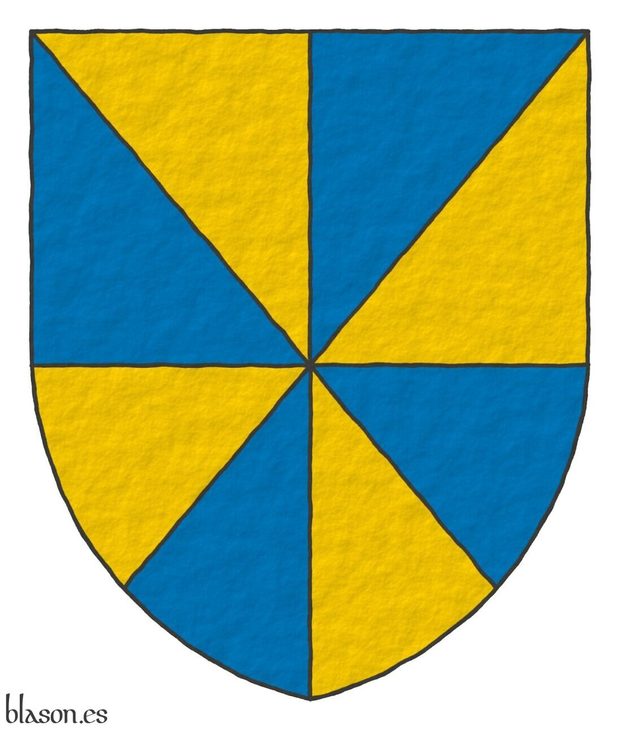
Vincent Manuscript, in English, usually written as «MS Vincent, 164 ff.1-21b», also called [St. George's Roll; 1285], it is in the College of Arms, London, containing 677 painted coats of arms, it is an English roll of arms dating from c. 1285.
Bibliographical reference of century XIII.
Classification: Armorial roll, Manuscript and In color.
Author: unknown.
Bibliographic reference mentioned in the following articles:
- Adam de Cretingges
- Bartholomew de Yattendon
- Edmund de Bassingburnn
- Howel ap Res
- James de Sottone, le Fitz
- Joan de Okinton
- John de Beauchamp
- John de Ladbrooke
- John le Sturmy
- Nicholas Malmains
- Norman Darcy
- Ricardo de Mandeville
- Robert de Malet
- Simon de Crombe
- Simon de Ver
- Simon le FizSimon
- St. George's Roll; 1285
- Thomas Roscelyn
- Thomas de Werblintone
- Thomas le FizThomas
- William Bardolf
- William de Ferrers, Earl of Derby
- William de Hondeshacre


![Ver [Williams, N.; 2017] en referencias bibliográficas. Libro abierto, hojas de plata, filo de oro, guardas de gules, tapas de sable.](../css/Libro.Bibliografia.png)
Williams, N.; 2017
Nicholas Williams, «Irish Heraldry: A Brief Introduction», written and illustrated by the author, 234 pages, published by Evertype, 72 Woodgrove, Portlaoise, R32 ENP6, Ireland, first edition, ISBN.10 1-78201-192-7, ISBN.13 978-1-78201-192-7, typeset in JansonText and Ceanannas by Michael Everson, cover design by Michael Everson and Nicholas Williams, printed by LightningSource, Portlaoise, 2017.
Irish
Also published in Irish by Evertype, ISBN 978-1-78201-139-2, copyright by Nicholas Williams, edited by Michael Everson Portlaoise, 2017.
Contents
- List of figures, page viii.
- Heraldry, page 1.
- When did the Gaelic chieftains adopt heraldry?, page 4.
- Native symbolism, page 13.
- Heraldic terminology, page 16.
- The heraldic achievement, page 19.
- Tinctures, page 22.
- The field, page 26.
- The ordinaries, page 31.
- Ornamental lines, page 38.
- The cross, page 40.
- The subordinaries, page 44.
- Animals, page 49.
- Birds, page 58.
- Fish, reptiles, and insects, page 62.
- Heraldic monsters, page 66.
- Human figures, page 70.
- Plants, page 73.
- Further charges, page 78.
- Blazon, page 91.
- The crest, etc., page 94.
- Supporters, page 99.
- The motto, page 102.
- The arms of women and the marshalling of arms, page 105.
- Differencing, page 111.
- The arms of Ireland and of the Provinces, page 119.
- Arms of towns and cities in Ireland, page 126.
- The arms of some famous people, page 134.
- Ecclestical heraldry, page 138.
- The Heralds, page 142.
- Heraldic jurisdiction in the modern world, page 149.
- Unauthorized arms, page 155.
- Miscellany, page 158.
- Abbreviations, page 163.
- Bibliography, page 164.
- Index of illustrations, page 166.
- General index, page 171.
- Plates, page 185 to 234.
Bibliographical reference of century XXI.
Classification: De bibliotheca, In color and English language.
The author is Williams, Nicholas.
Bibliographical reference mentioned in the following article:
Internal resources: Physical book on paper.
-
Language
-
Categories of heraldry
-
Divisions of the field
- Without divisions
- Party per pale
- Party per fess
- Party per bend
- Party per bend sinister
- Tierce
- Tierce sinister
- Tierced per pale
- Tierced per fess
- Tierced per bend
- Tierced pallwise inverted
- Quarterly
- Quarterly per saltire
- Gyronny
- Party per fess, the chief per pale
- Party per pale, the sinister per fess
- Party per fess, the base per pale
- Party per pale, the dexter per fess
- Chapé
- Chaussé
- Embrassé
- Contre-embrassé
- Party per chevron
- Enté
- Enté en point
- Flanched
-
Metals
-
Colours
-
Furs
-
Other tinctures
-
Ordinaries and sub-ordinaries
-
Diminutives of the ordinaries
-
Other charges
-
Inanimate charges from Nature
Atom, Crescent, Diamond, Emerald, Estoile, Increscent, Lightning flash, Moon, Mount, Mullet, Mullet of four points, Orbital, Plough of Ursa Major, Rainbow, Ray of the sun, River, Sea, Snowflake, Sun, Sun in splendour, Sun of May, Trimount and Water.
-
Vegetal charges from Nature
Acorn, Apple, Apple tree, Ash, Bluebonnet, Camellia, Chrysanthemum, Cinquefoil, Cornflower, Dogwood flower, Double rose, Elm, Fleur de lis, Flower, Holm oak, Hop cone, Kapok tree, Laurel, Lily, Linden, Lotus flower, Madonna lily, Oak, Olive tree, Palm tree, Pomegranate, Poplar leaf, Rose, Shamrock, Sunflower, Thistle, Tree, Tulip, Vine and Wheat.
-
Animal charges from Nature
Badger, Bald eagle, Barbel, Barn owl, Bear, Beaver, Beetle, Bighorn sheep, Blackbird, Boar, Brach hound, Bull, Doe, Dog, Dolphin, Dove, Eagle, Elephant, Falcon, Fish, Flame, Fly, Fox, Frog, Goat, Goldfinch, Goose, Heron, Horse, Hummingbird, Jaguar, Lark, Leopard, Lion, Lion passant, Lion rampant guardant, Lioness, Lynx, Male figure, Martlet, Merino ram, Owl, Panther, Parrot, Peacock, Pelican, Pelican in her piety, Puffin, Quetzal, Raven, Roe deer, Rooster, Savage, Seagull, Serpent, She-wolf, Stag, Starling, Tyger, Vulture, Warren hound and Wolf.
-
Parts of natural charges
Arm, Beak, Branch, Caboshed, Chest, Claw, Covert, Dorsal fin, Eagle claw, Ermine spot, Escallop, Feather, Foot (palmiped), Foreleg, Forepaw, Hand, Head, Heart, Hoof, Leaf, Neck, Ostrich feather, Palm frond, Paw, Roe deers' attires, Shoulder, Sprig, Stags' attires, Stem, Swallow-tail, Tail, Tail addorsed, Tail fin, Talon, Tooth, Trunk, Trunk (elephant), Two hands clasped, Two wings in vol, Udder, Wheat spike, Wing and Wrist.
-
Artificial charges
Ace of spades, Anchor, Anvil, Arch, Arm vambraced, Armillary sphere, Arrow, Axe, Bell, Bell tower, Beret, Bonfire, Book, Bookmark, Bow, Bridge, Broken, Buckle, Cannon, Cannon dismounted, Cannon port, Canopy roof, Carbuncle, Castle, Celtic Trinity knot, Chain, Chess rooks, Church, Clarion, Clay pot, Closed book, Club, Comb, Compass rose, Conductor's baton, Cord, Covered cup, Crozier, Crucible, Cuffed, Cup, Cyclamor, Dagger, Double vajra, Drum, Ecclesiastical cap, Fanon, Federschwert, Fleam, Four crescents joined millsailwise, Galician granary, Garb, Gauntlet, Geometric solid, Grenade, Halberd, Hammer, Harp, Host, Hourglass, Key, Key ward, Knight, Knot, Lantern, Letter, Line, Loincloth, Menorah, Millrind, Millstone, Millwheel, Monstrance, Mortar, Mullet of six points pierced, Nail, Non-classic artifact, Norman ship, Number, Oar, Oil lamp, Open book, Page, Pair of scales, Parchment, Pestle, Piano, Plough share, Polish winged hussar, Port, Portcullis, Potent, Quill, Ribbon, Rosette of acanthus leaves, Sabre, Sackbut, Sail, Scroll, Scythe, Sheaf of tobacco, Ship, Skirt, Spear, Spear's head, Stairway, Star of David, Step, Sword, Symbol, Tetrahedron, Torch, Tower, Trident, Trumpet, Turret, Two-handed sword, Wagon-wheel, Water-bouget, Wheel, Winnowing fan and With a turret.
-
Immaterial charges
Angel, Archangel, Basilisk, Dragon, Dragon's head, Garuda, Golden fleece, Griffin, Heart enflamed, Mermaid, Our Lady of Mercy, Ouroboros, Paschal lamb, Pegasus, Phoenix, Sacred Heart of Jesus, Saint George, Sea-griffin, Trinity, Triton, Unicorn, Winged hand and Wyvern.
-
External elements
-
Heraldic creations
-
References
-
Formats
-
Keywords on this page
Armorial roll, Article, Bend, Bibliography, Surmounted, Chain, Certification, De bibliotheca, Dictionary, Doctor, Heraldic document, In color, Genealogy, Isch, German language, Castilian language, French language, English language, Latin language, Portuguese language, Manuscript, Orle, Or, PDF, Argent, Without divisions, Social networks, Kingdom of Castile and Leon, Kingdom of England, Sable, Century XI, Century XIII, Century XIV, Century XV, Century XVI, Century XVII, Century XX, Century XXI, Technology and Video.
